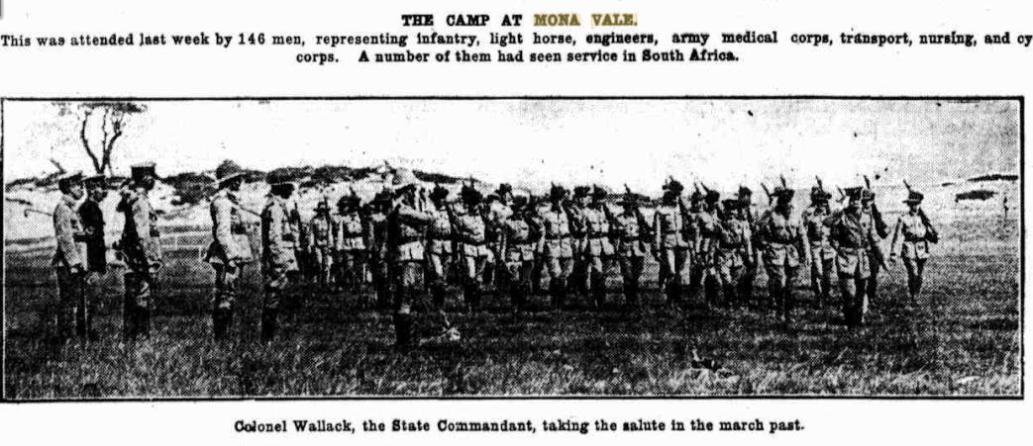October 23 - 29, 2016: Issue 286
Remembrance Day 2016: War Memorials - Mona Vale, November 14, 1926
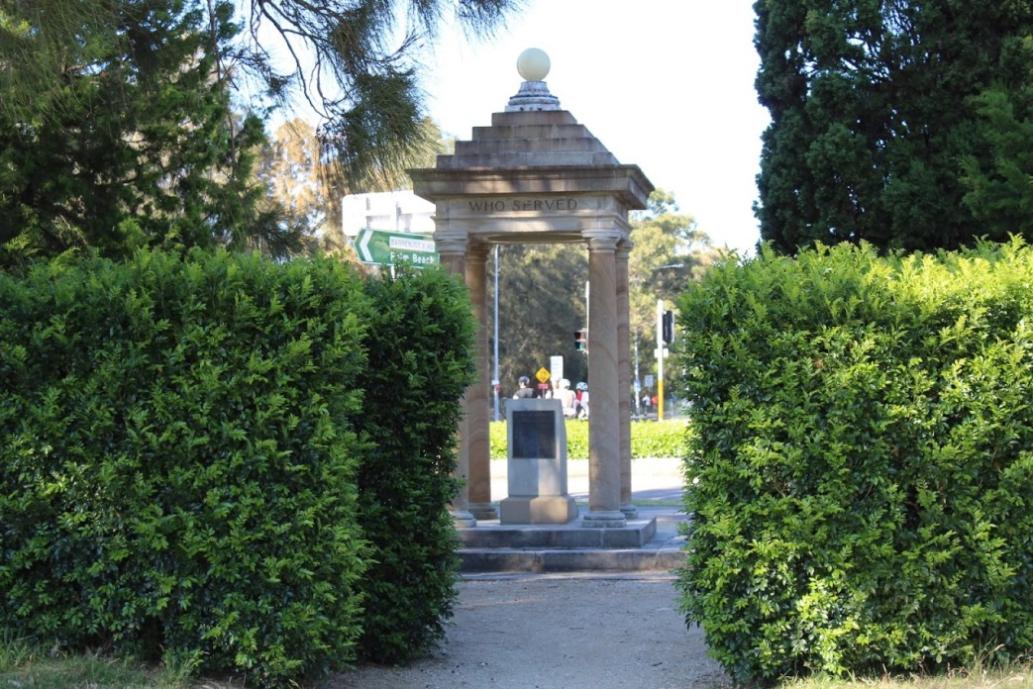
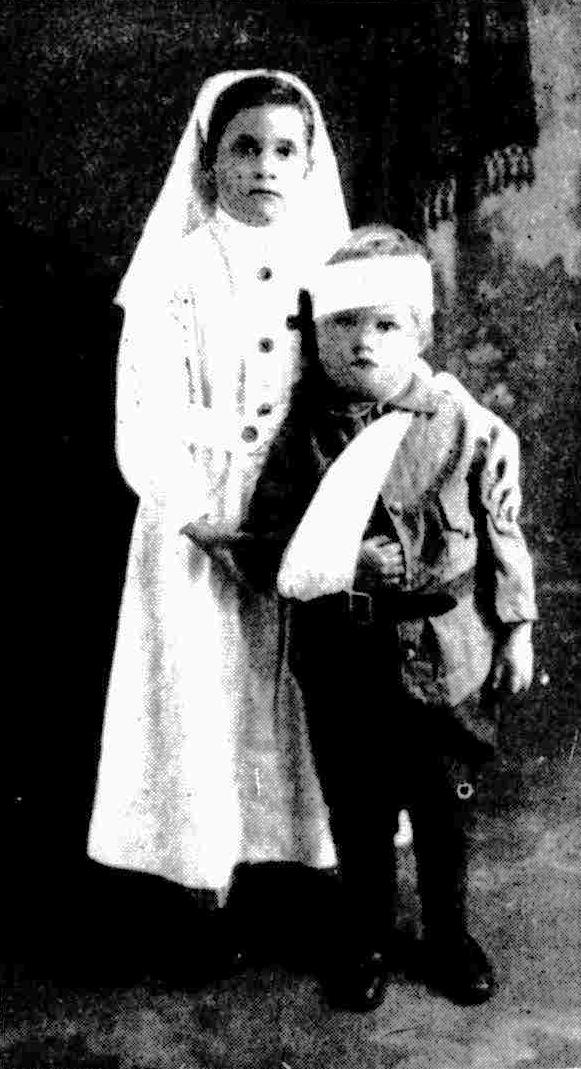
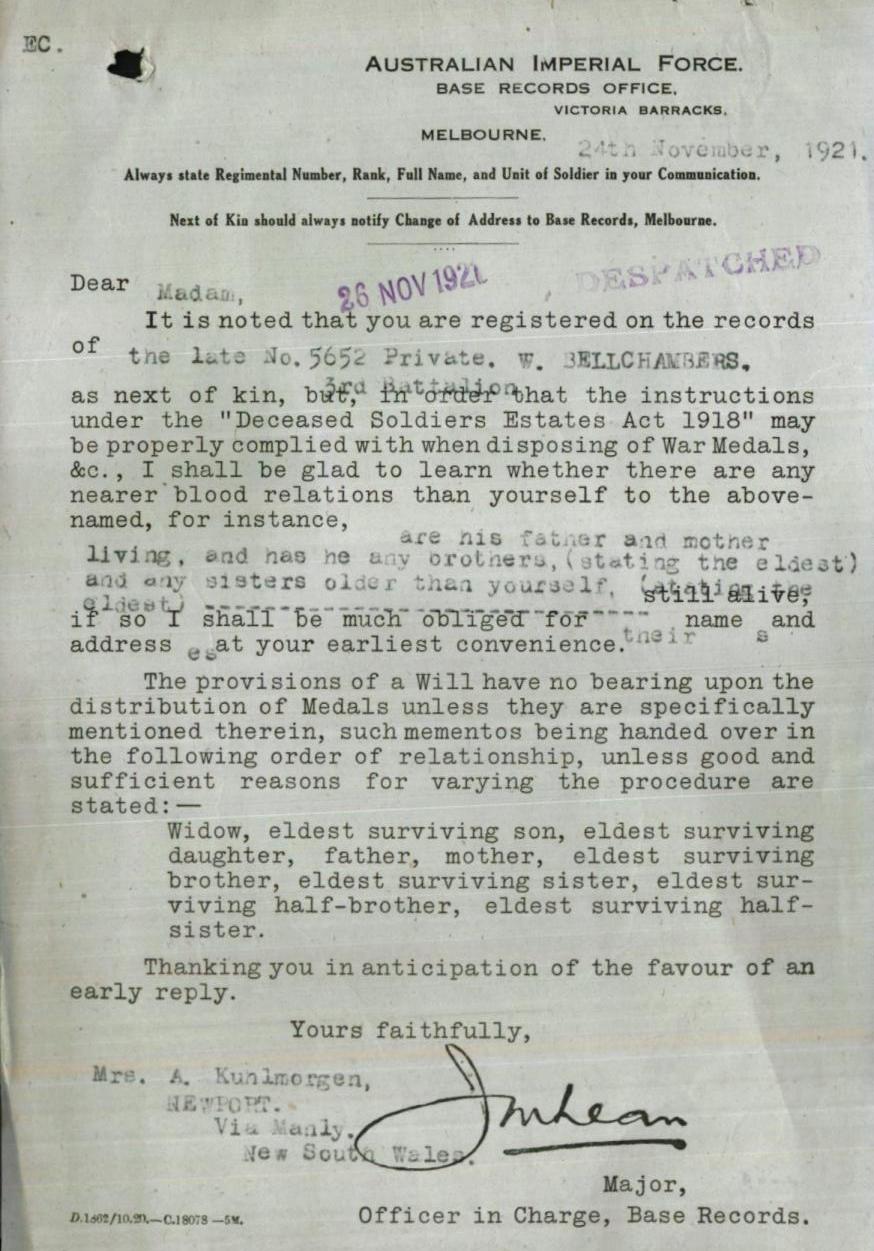
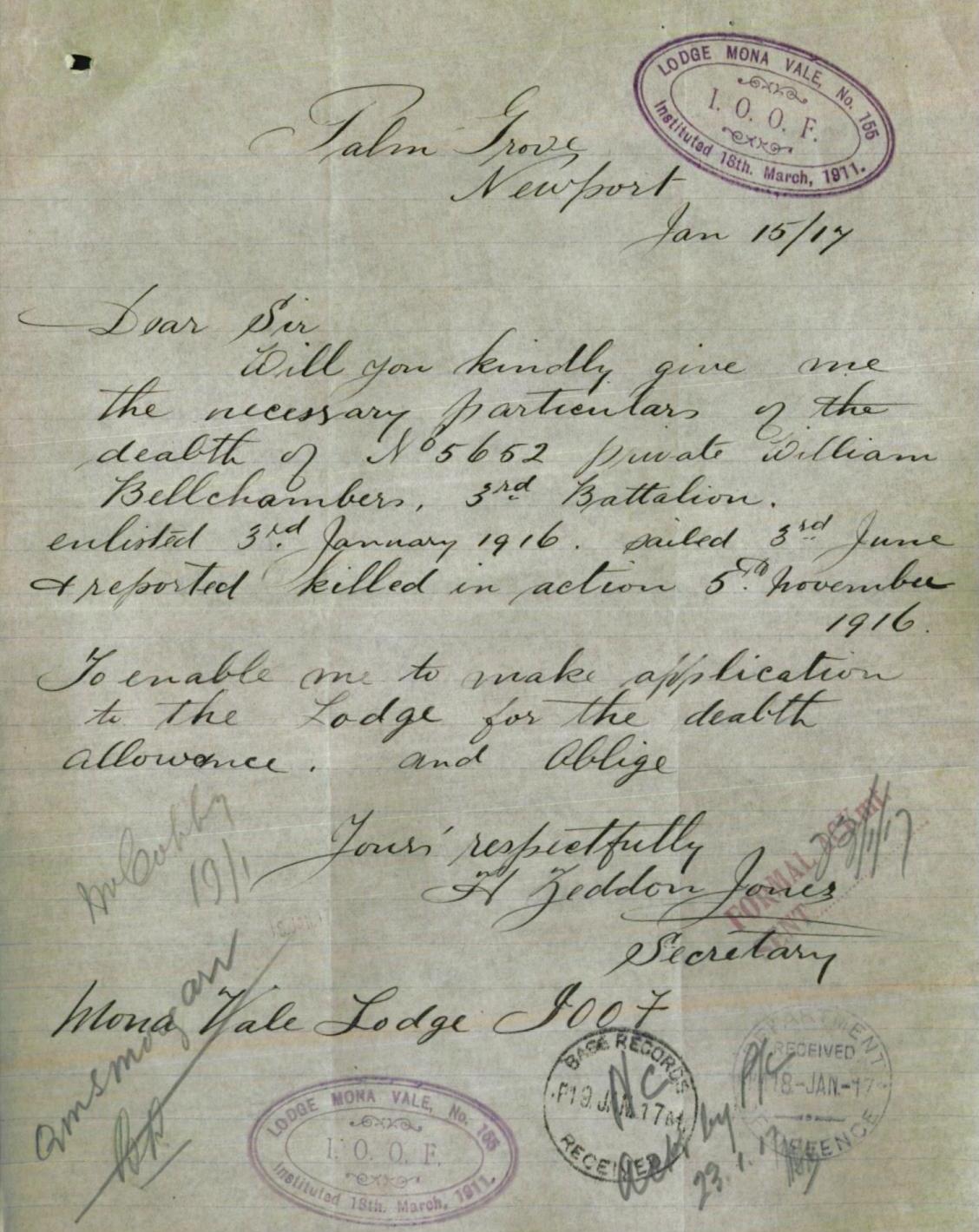
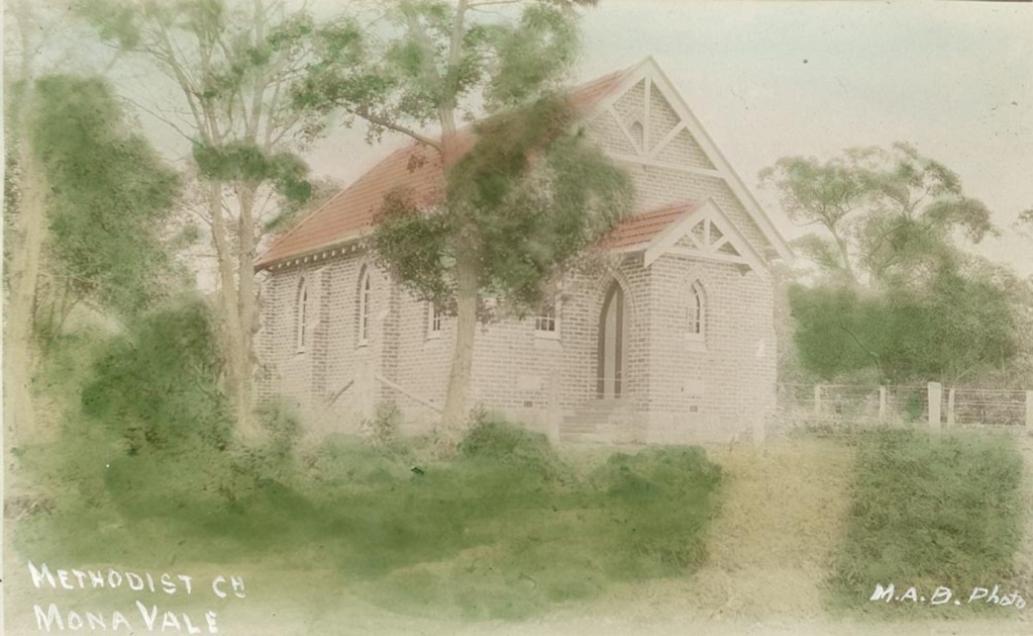
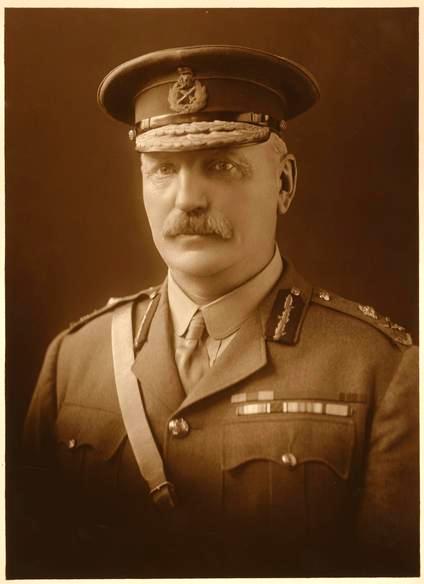 Major General Sir Granville de Laune Ryrie KCMG, CB, VD (1 July 1865 – 2 October 1937) was an Australian soldier and politician who served in the Second Boer War and the First World War. Ryrie was born in Michelago, New South Wales on 1 July 1865, into a farming family. His father was Alexander Ryrie, a grazier and member of the New South Wales Legislative Assembly (1880–91) and of the Legislative Council (1892–1909), and his mother was Charlotte, née Faunce, both born in New South Wales. Granville was educated at Mittagong and at The King's School, Sydney; he later became a jackaroo, and eventually managed his own property. He was also a good heavyweight boxer. In 1896 he married Mary McFarland, whom Ryrie nicknamed "Mick". Mary McFarland was the daughter of Sir Alfred McFarland (1824–1901), a judge in New South Wales.
Major General Sir Granville de Laune Ryrie KCMG, CB, VD (1 July 1865 – 2 October 1937) was an Australian soldier and politician who served in the Second Boer War and the First World War. Ryrie was born in Michelago, New South Wales on 1 July 1865, into a farming family. His father was Alexander Ryrie, a grazier and member of the New South Wales Legislative Assembly (1880–91) and of the Legislative Council (1892–1909), and his mother was Charlotte, née Faunce, both born in New South Wales. Granville was educated at Mittagong and at The King's School, Sydney; he later became a jackaroo, and eventually managed his own property. He was also a good heavyweight boxer. In 1896 he married Mary McFarland, whom Ryrie nicknamed "Mick". Mary McFarland was the daughter of Sir Alfred McFarland (1824–1901), a judge in New South Wales.SOLDIERS' MEMORIAL AT MONA VALE.
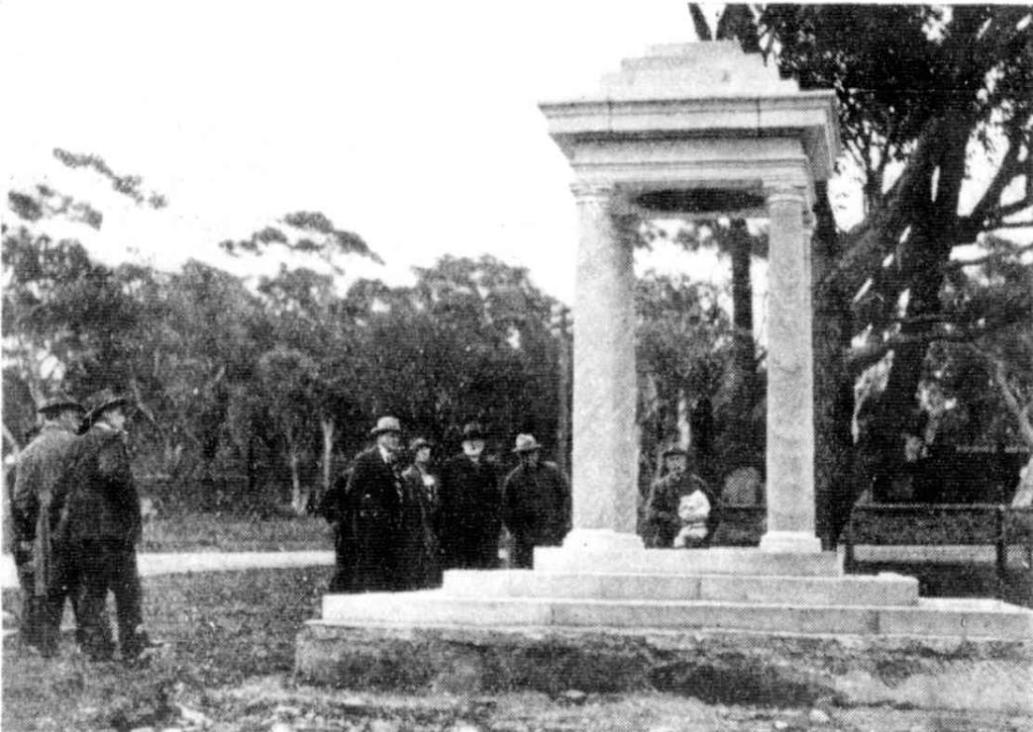
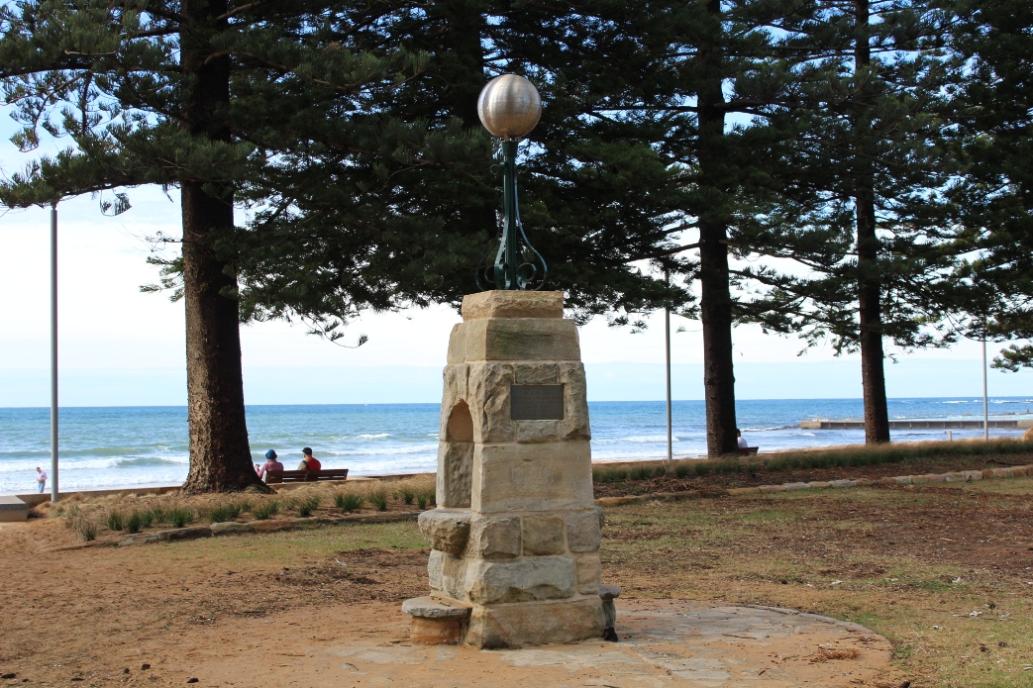
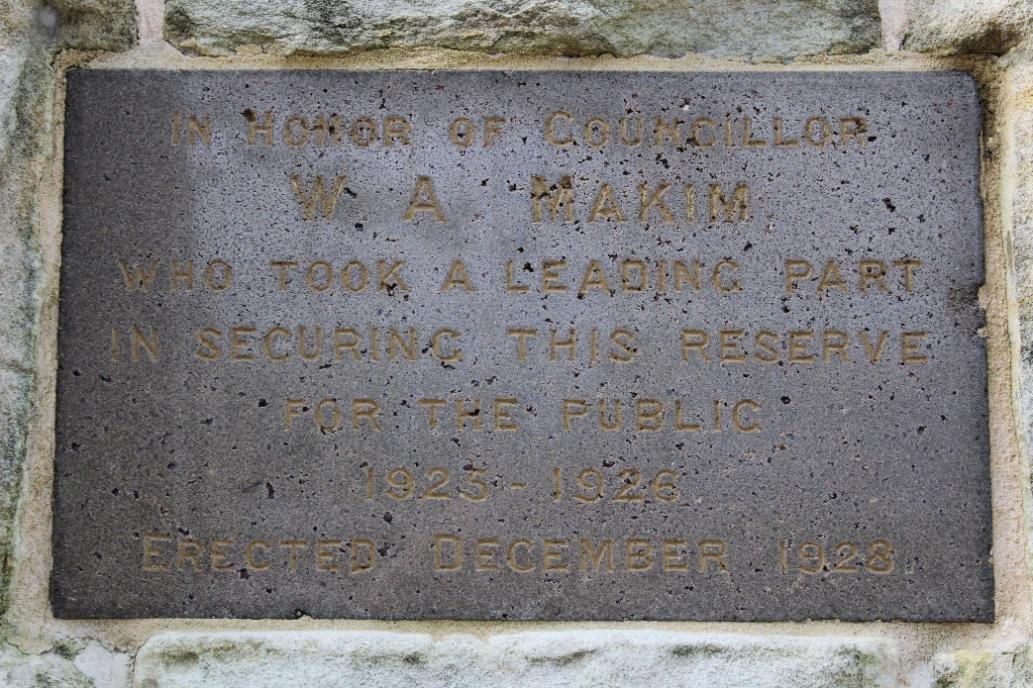
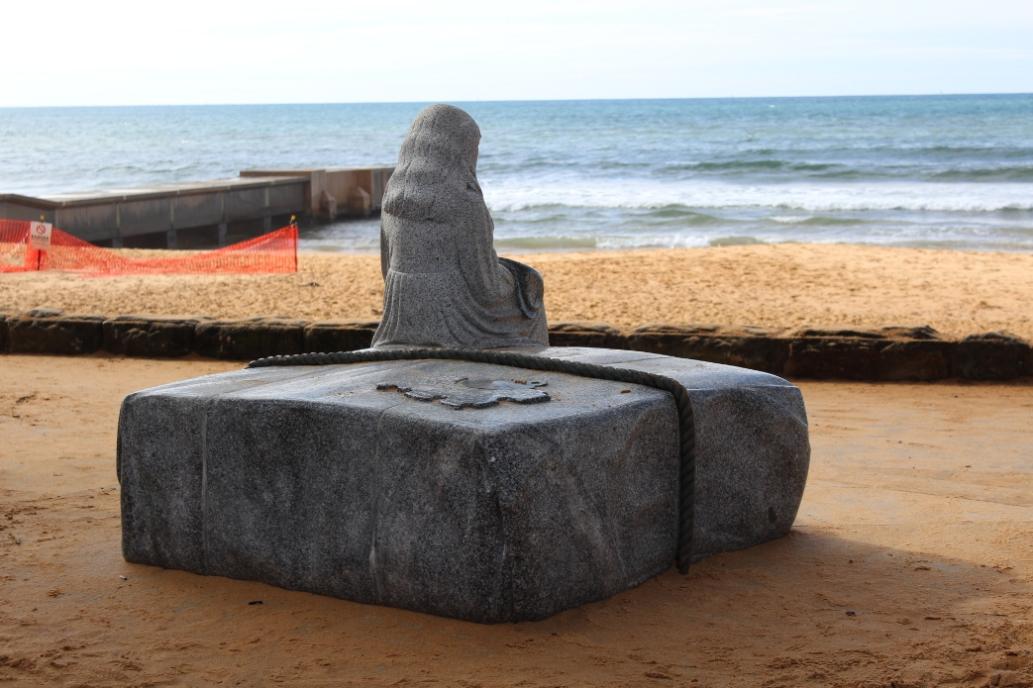
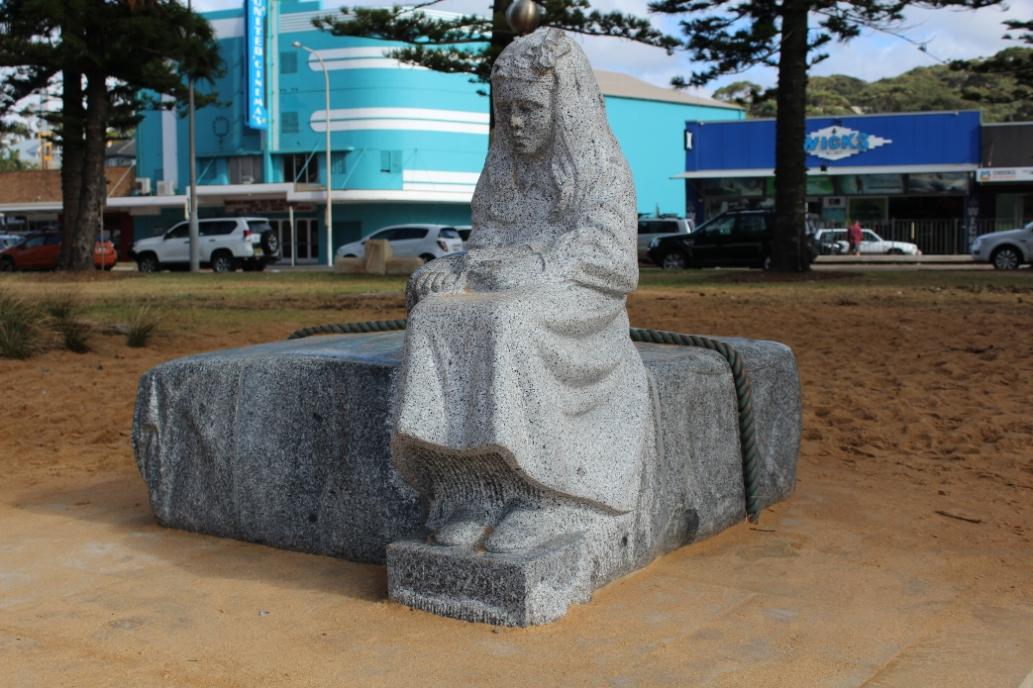
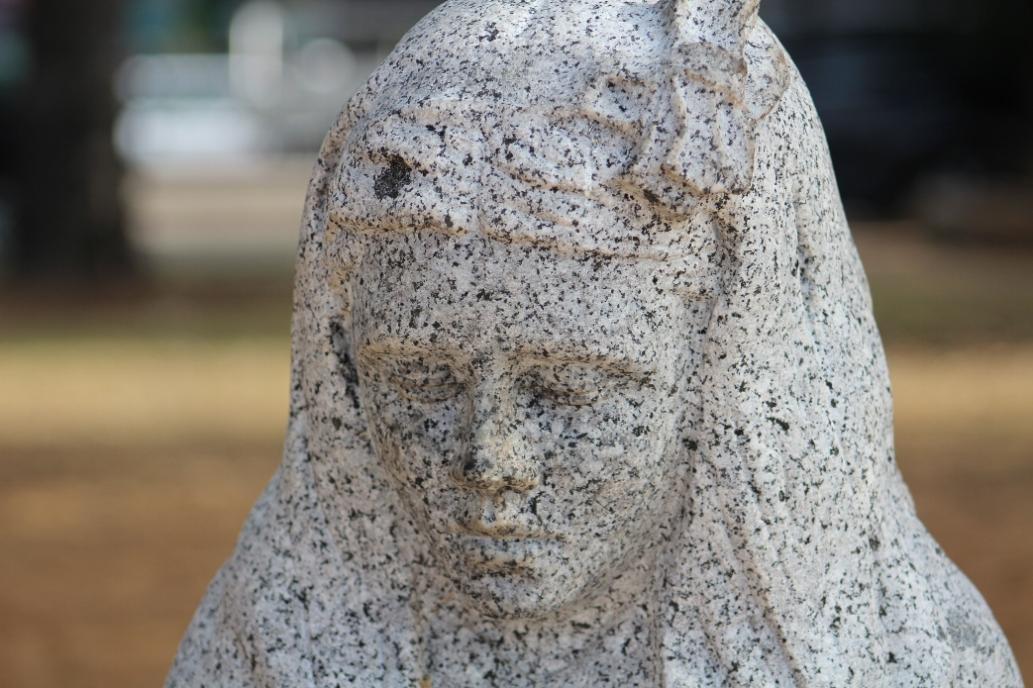
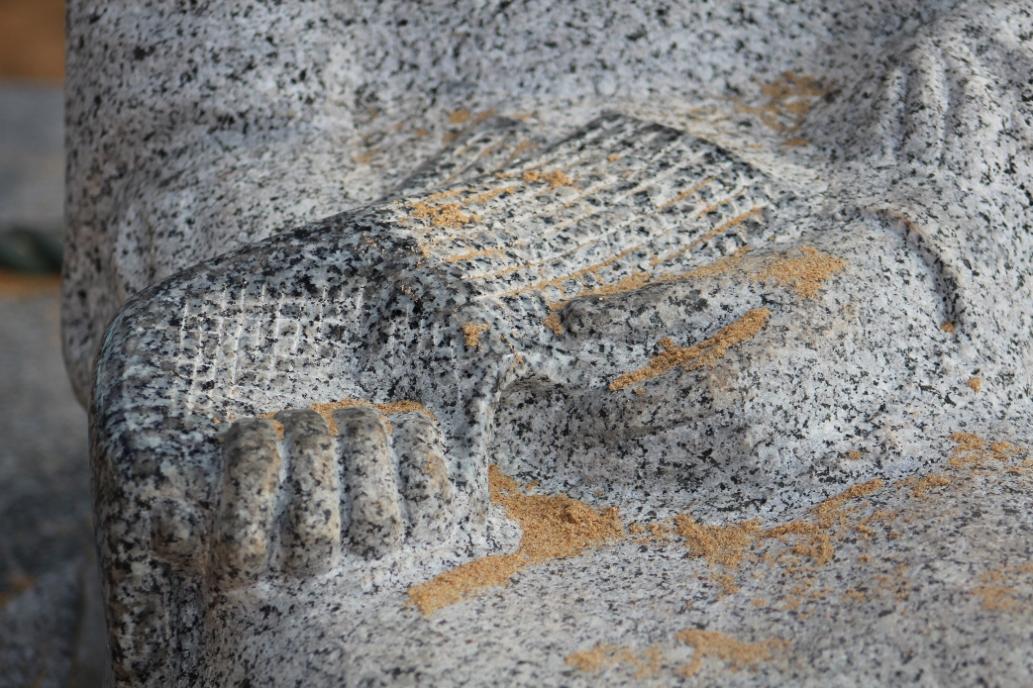
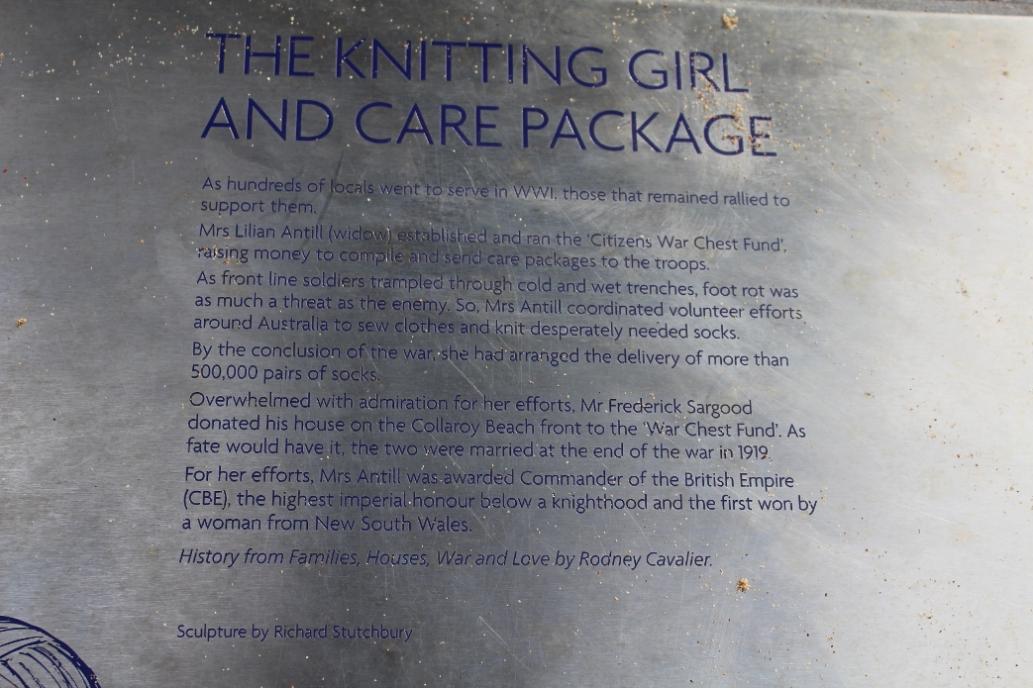
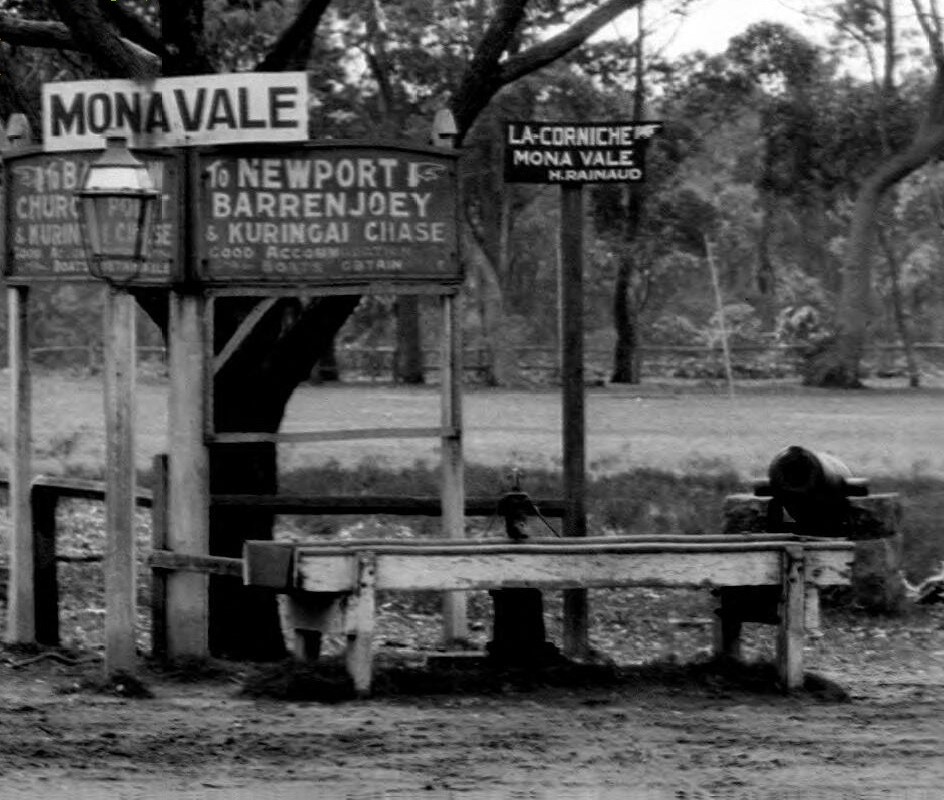
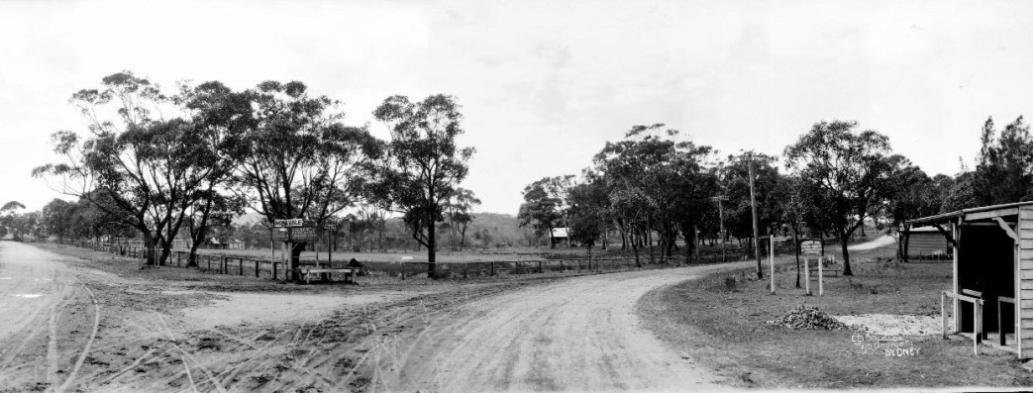
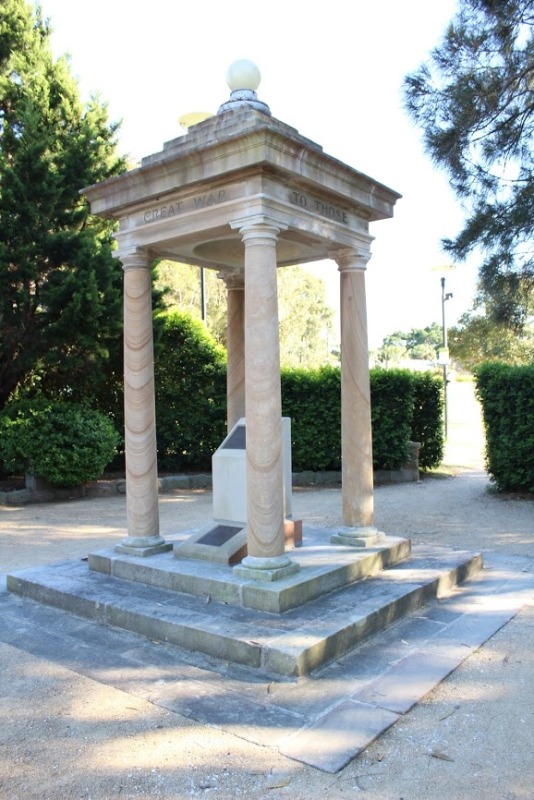
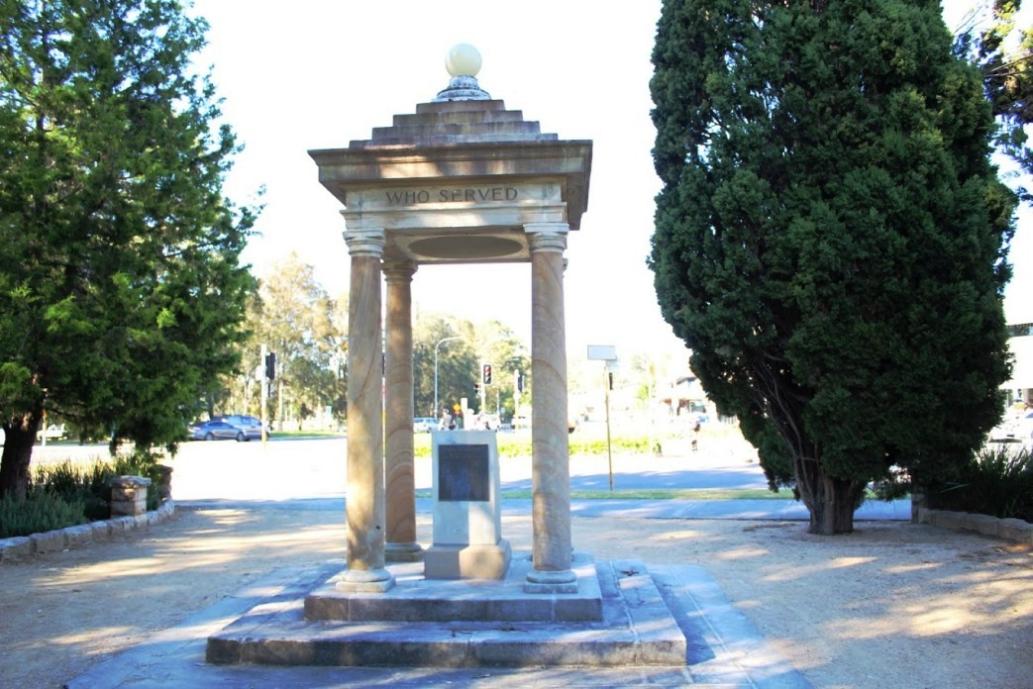
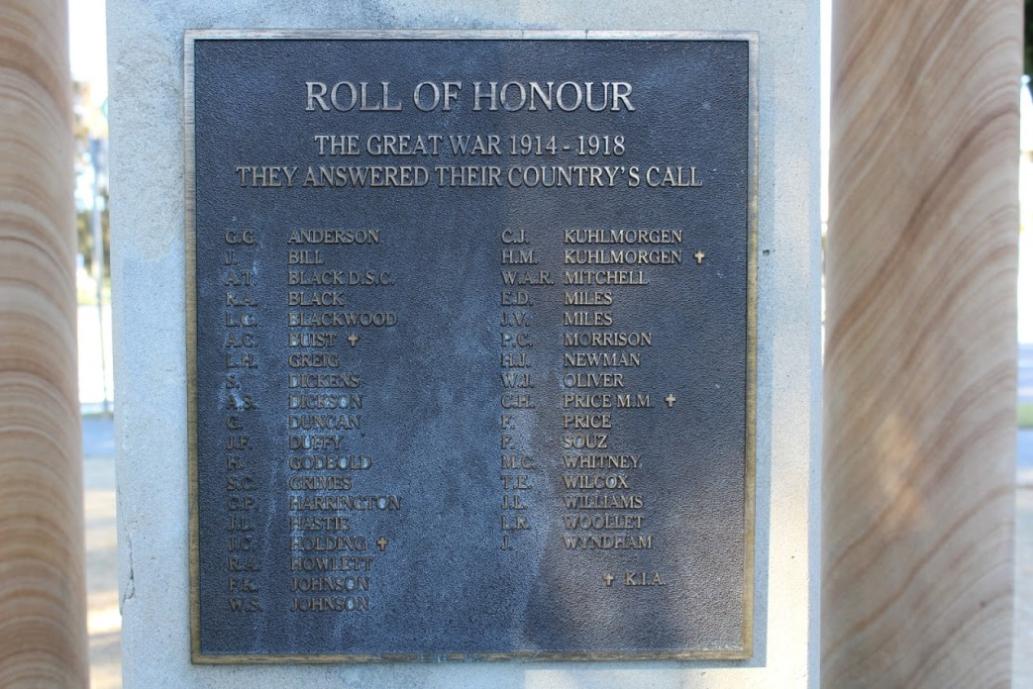
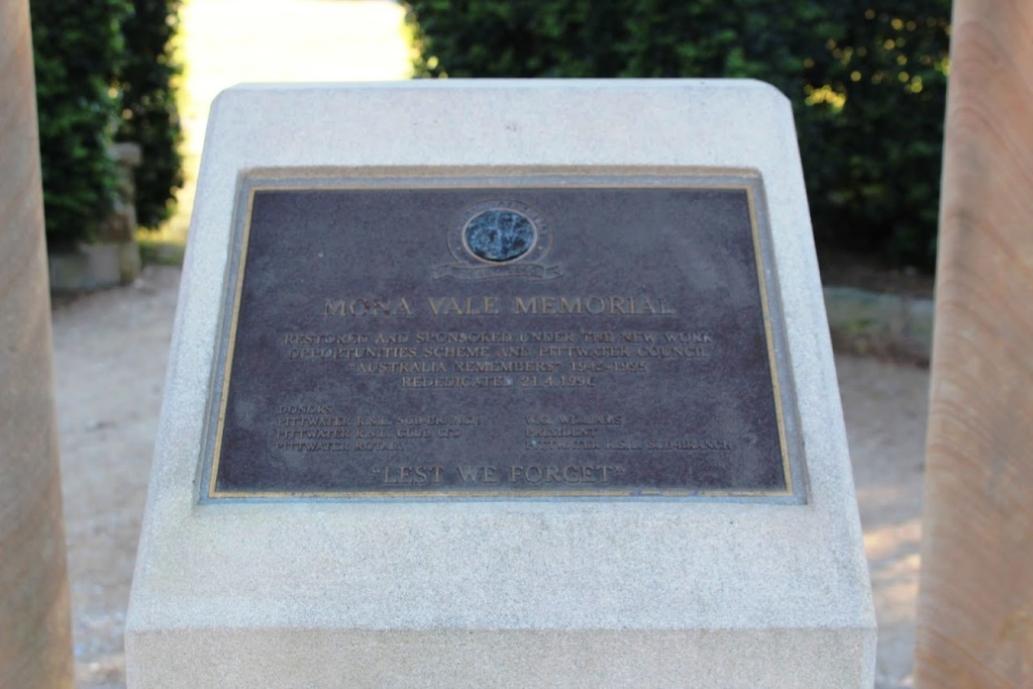
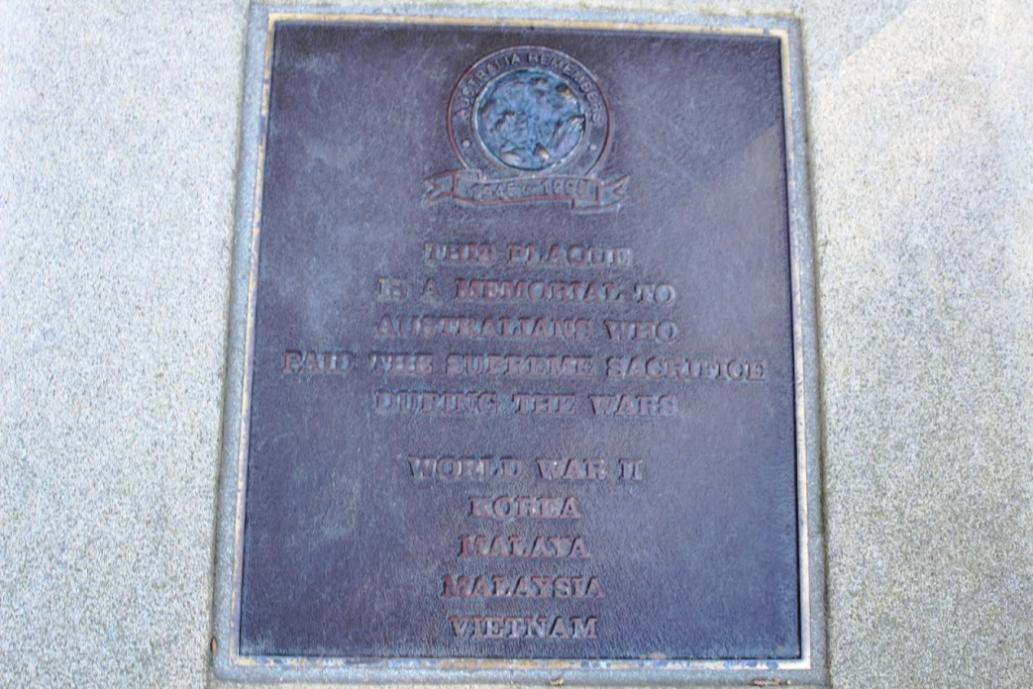
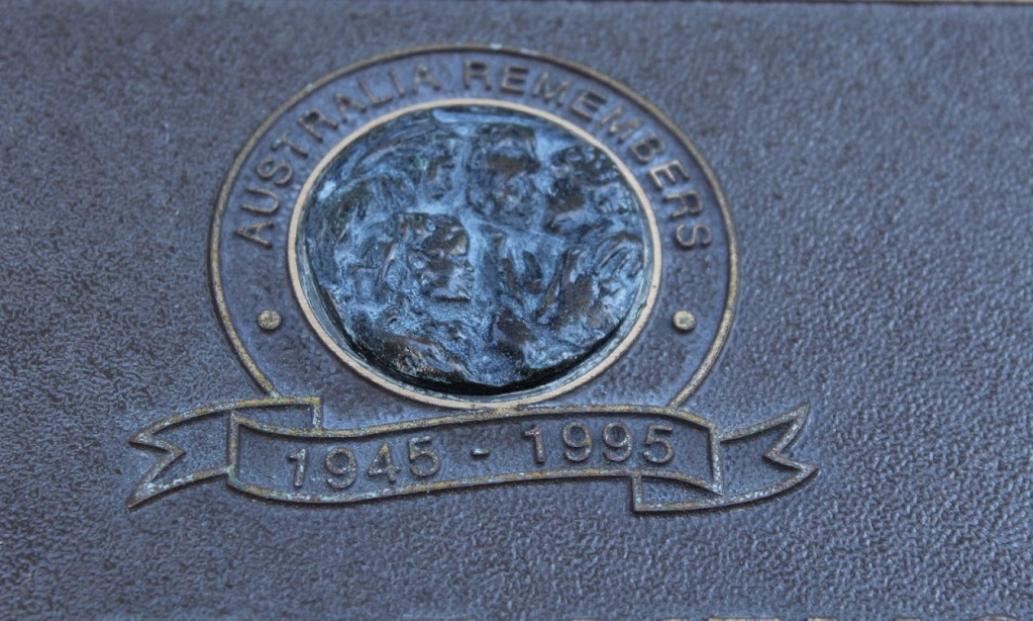
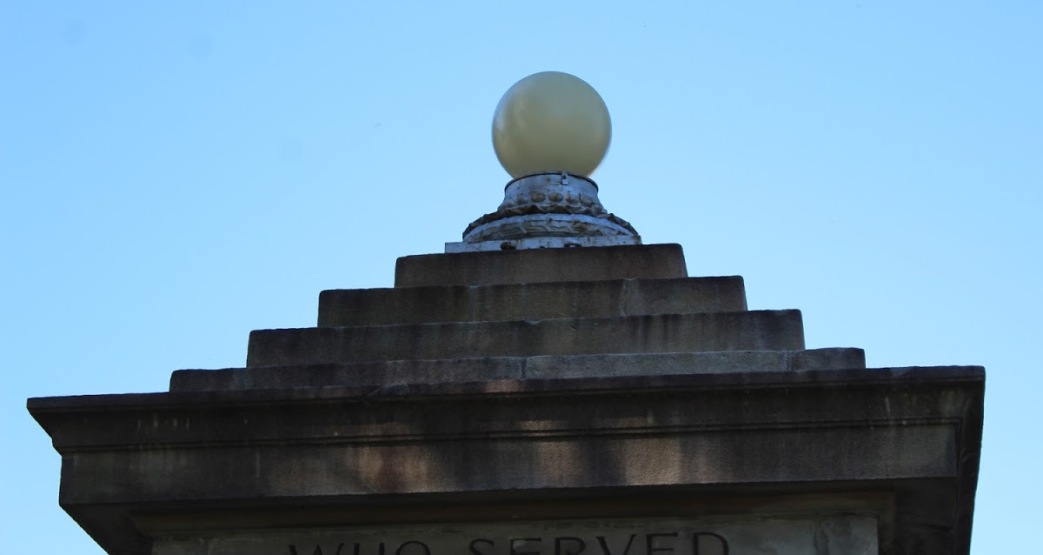
Notes And Extras
Remembrance Day 2011 at Avalon Beach RSL Pictures
Remembrance Day 2013 Commemorative Service at Avalon Beach RSL Cenotaph
Remembrance Day 2014 Service at Avalon Beach RSL Sub-Branch - Mayoral Address Pictures
Remembrance Day Service at Avalon Beach RSL Cenotaph: 2015 - Mayoral Address
Remembrance Day Writers 2011: family anecdotes from Doreen Cherry, Margaret Millar and David James
Remembrance Day Writer 2012: The Loom Of The Lights Of London by Martin Thordnycraft
Remembrance Day Writers 2013: Kenneth Lindsay Wright Flight Sergeant, PRU and POW WWII by 'Lofty' Wright and compiled by Brad Fisher
Honorary Rank for World War II pilot Ken Wright
Remembrance Day Writers 2014: The HMAS Sydney Stops RMS Emden – 100 Years Ago Today - a pre Remembrance Day 2014 insight into the newly fledged Royal Australian Navy's first victory from the mouths of those who were there
Remembrance Day Writers 2015: Christopher Chubb Profile POW WWII in Hong Kong as a child, National Serviceman during the Malayan Emergency as part of one of the world’s oldest Regiments, the King’s Dragoon Guards, rising to the rank of Lieutenant.
Front Page Issue 188 - Poppyman at War Veterans Village Narrabeen Gallipoli Centre 11.11.2014
Royal Motor Yacht Club - Broken Bay Grand Opening of the 2012-2013 Boating Season - IFR 2013 Announced
First Naval Exercises by New South Wales Colonial Ships –The Wolverene at Broken Bay - It may not surprise many of you that the first ever Naval Exercises carried out by colonial vessels began from Broken Bay – where else? In the lead up to the International Fleet Review in Sydney Harbour, October 3-11 2013, celebrating the entry of our own Royal Australian Navy fleet into Sydney Harbour 100 years ago, we will share a few articles on the lead up events to this original great day for New South Wales and Australia. First though - Colonial Naval Ships Exercises; 1885...
From Colonial Navy Brigades in Second Hand Ships to Where the Australian Navy was Born – The Practical Verses of William Rooke Cresswell’s Charter - International Fleet Review 2013 precursors - Article II
The Arrival of the Australia's Navy in Sydney Harbour - 4th of October, 1913 - International Fleet Review 2013 precursors - Article III
The Australian Fleet Celebrations of October 1913 - A Week of Welcomes- International Fleet Review 2013 precursors - Article IV
International Fleet Review Pictorial from RAN Fleet Entance on 4th of October 2013 to Sydney Harbour by Brian Friend OAM - retired Water Policeman
Methodist Churches On Northern Beaches
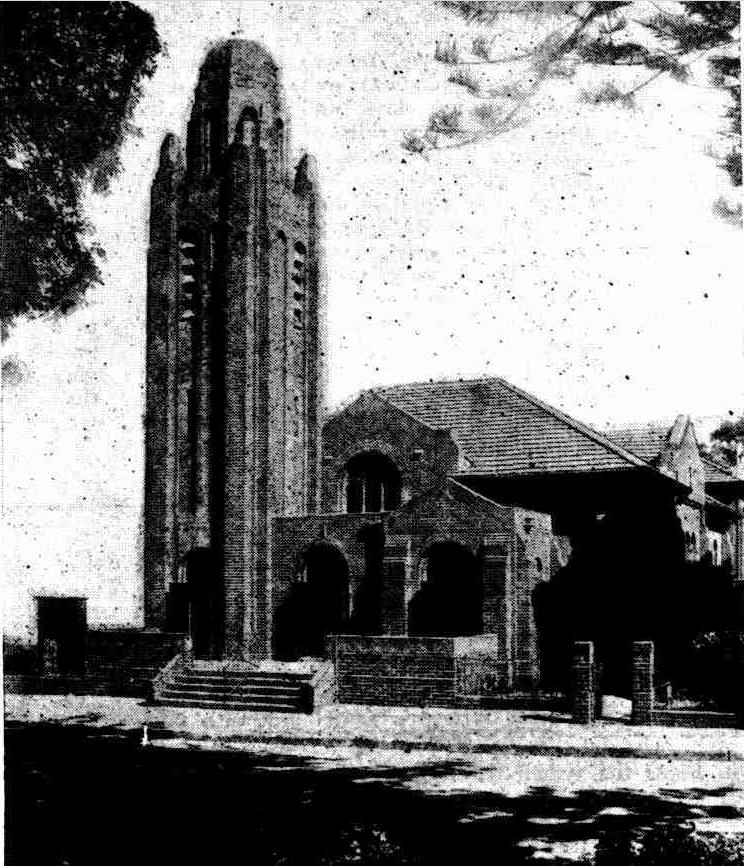
Mona Vale Oddfellows Lodge
WHERE TO SPEND THE WEEK END. MONA VALE
(BY MARCUS SUBURBUS.)
THE STORY OF BROCK'S FOLLY.
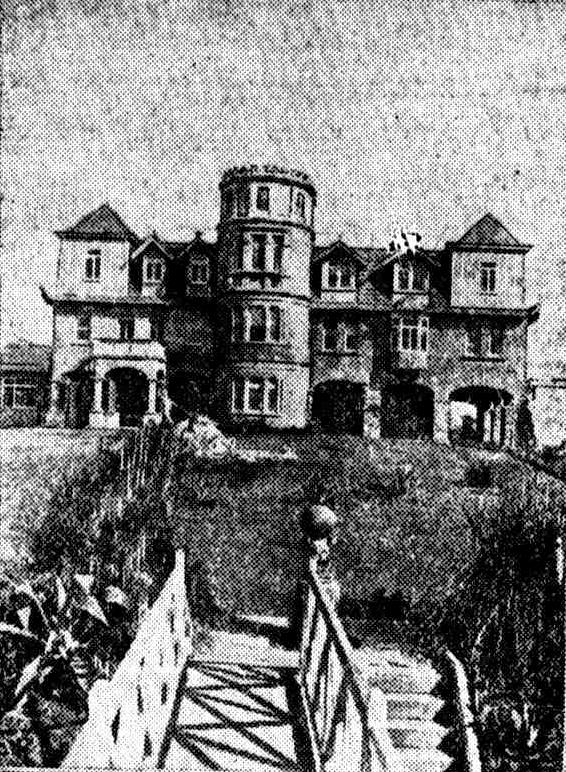
THE MONA VALE HYDRO.
Sydney Is indebted to the misdirected and inspired energy and enterprise of a man of whom, perhaps not one In five hundred knows anything at all for one of the most magnincent examples of palatial architecture that grace the outer circle of its environs. This beautiful and stately pile of buildings represents a great— a masterly— idea, which cost its unfortunate originator £25,000, and left him practically beggared. Sixteen or so years ago this man with an idea noted the great unclaimed swamp at 'Mona Vale— a stagnant lagoon, the only point in its favor being its proximity to a fine ocean beach, one of the many that enrich that much-favored stretch of coast from Manly up to Pittwater, and beyond. It occurred to him that if this useless blot upon the landscape could be drained an excellent seaside estate should result. And then the idea germinated. The unpromising-looking land was purchased for £600, and then the New South Wales Government was approached with the proposition that the buyer was prepared to spend £25,000 upon this site, providing a start was made upon the Pittwater tramway that had so long hovered mirage-like before the inhabitants of the district. .The Man with the Idea even offered to build the line' himself, should the Government withhold its hand, and called on the Minister for Works with a cash deposit of £10,000 to prove his sincerity. But the Government, apparently satisfied by these representations that the need of the district was pressing and genuine, promised to undertake the construction of the line a once. And the buyer, secure in the Government's promise, allowed his great idea to blossom instantly into the concrete expression of bricks and tiles and timber.
THE GREAT IDEA. And the idea was this: To build a huge village upon the drained lands of the estate, dominated by a magnificent clubhouse, and to sink £25,000 in the realisation of this immense scheme. To prove a financial success, access by tram to the estate was the one thing absolutely necessary. And this the Government had promised. The Man with the Idea set about the carrying out of his .purpose on a splendid scale. On the site he erected his own brickworks for the manufacture of the bricks and tiles: he bought a timber area at Erina Creek, on the Hawkesbury River, installed a timber mill and a planing machine as well, and so cut, freighted, and treated his own timber on the spot. He worked his own quarry, drawing from it all the needful stone, drained the swamp, obtained a regular water supply by the construction of a great brick and cement tank,' 20Ct. wide and 14ft. deep, and Installed a complete sewerage system. And all the while the promised tram was creeping out from Manly, slowly but surely. By the time it had reached Curl Curl, 12 months after its start, the walls of a mansion, or rather of a group of mansions, at Mona Vale were roof high, and the great idea was flowering in wood and stone and brick towards completion and perfection. The sum of £10,000 had already been sunk in initial expenses, and a further £15,000 borrowed to complete the work, and that work promised to be indeed a "thing of 'beauty and a joy forever." Forever, for the floors of the main building were built on a layer of concrete covered with a layer of bitumen and sawdust, upon which were laid 5000 hardwood sleepers, , and upon them another layer of sawdust and bitumen, and then the parquet flooring— a foundation impervious to white ants, and for all practical purposes everlasting. A hundred carpenters were at work, as well as a great host of other mechanics, and the loud ringing music of labor, which is the voice of progress, echoed and re-echoed' throughout Mona Vale. And the setting of the picture was as beautiful as the immense building rising under trowel and mallet and hammer. In the foreground two crescent-curves of hard, fine, sand, fronting the sea; beautiful green seaward sloping lands, and green embracing' bills. Meanwhile the grounds about the mansion were being decorated with statues and playing fountains, and among other costly and artistic fittings a great majolica mantel, that had originally cost £720, was In stalled in the entrance ball of the palatial place.. It was plain that the Man with the Idea had invested more than his mere capital In this sumptuous scheme. Something must have stirred in him that was akin to the emotions of all great builders, from Solomon of old and Darius the Persian, down to Christopher Wren and the designer of the flatiron building in New York. And Mona Vale on the New South Wales coast was in touch with the same spirit that reared the pyramids and built the Hanging Gardens of Babylon.
THE FATE OF THE SCHEME. And it Is just here In the story that the fateful tram stopped. It had reached Curl Curl, one mile out from Manly, and there "it stayed, just 10 miles short of Mona Vale, and its waiting palace. Perhaps the authorities judged that a pleasant ten-mile tramp, bag in band, would be just the thing for intending guests, considering the invigorating air of the locality. Perhaps not. Anyhow, the mortgagors who had loaned their £15,000 in expectation of a tramline that would go a good deal further than Curl Curl Lagoon began to look dubious. Then, "at this psycho logical moment," as the novelists say, the Government that had guaranteed the tram bore tragic testimony to the instability of all human institutions, by going the way of all flesh. In short, it went out of office, and its tramline promise passed into the limbo of forgotten things, together with a variety of other departmental lumber. Matters began to look exceedingly serious. The £25,003 was gone, and although £S300 had been paid off the borrowed £15,000, a balance of GOOO, which Included Interest, re mained, and there was no Immediate prospect of the property returning it. But the Man with the Idea was not wholly beaten yet: Surmising that perhaps if a ready-made population were provided first, the tardy tram might reasonably be expected to follow them, he determined to sacrifice practically the whole of the area, including the recreation reserve, and the grounds surrounding the house, to pay the balance of the mortgage. The site had been actually surveyed for subdivision, when the wheel of his enterprise was effectually spiked again. The shire refused to approve of the plan until £1500 was deposited for the construction of the streets, and so, operations were again brought to a stand still. At this point the unfortunate successor of Darius, Barneses', and Christopher Wren was informed that the Government wished to purchase the entire property as it stood, and desired to know his price. ' He named the comparatively utterly insignificant sum of £7500, explaining that he needed £6500 to pay off the mortgagors, and £1000 to wipe off money owing for material supplied. He did not ask for one Sixpence for himself; only for sufficient to clear him of his obligations. He had failed, losing everything; but he wished to face the world with a clean sheet. However, the Government's emissary, after hearing the story, went to the mortgagors to negotiate. Naturally all they asked for was their £6500, and the Government, falling in with this request, took over the entire concern for that sum. So the Man with the Idea was turned adrift with £1000 worth of debts upon his shoulders, and not a penny saved from the wreck: while his £25,000 palace had been sold for £6500 Such is the story of Brock’s Mansion at Mona Vale, and surely the misfortune of the unlucky builder from whom it takes its name is almost unique.
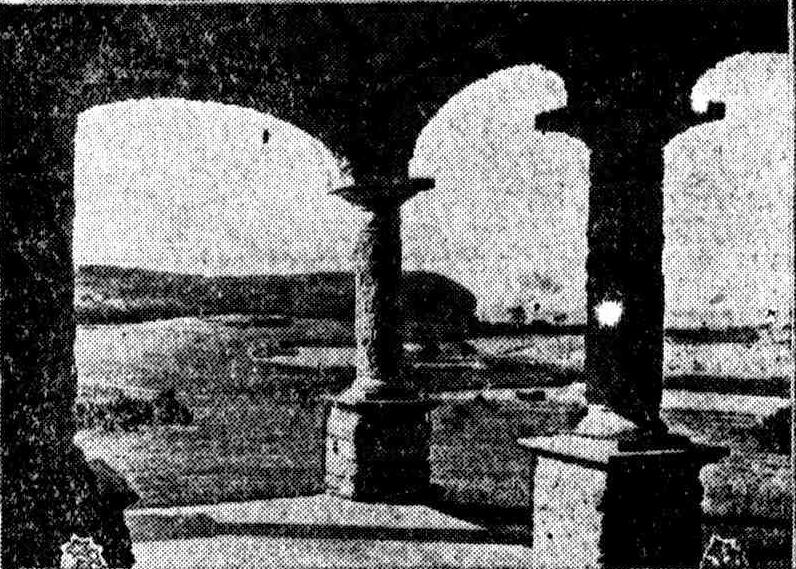
BROCK'S ESTATE FROM THE HYDRO.
BROCK'S ESTATE TO BE SOLD.
The sequel to the story of what has come to be known as "Brock's' Folly" promises to be good reading. It will doubtless prove a tale of pioneering such as all Australians delight in. There is every' Indication that In a few years the magnificent estate which was intended for the mansion grounds will become the scene of one of the most beautiful seaside settlements in the State. Mona Vale might have been designed by Nature as a resort of rest and delicious peace. Brock's Estate fronts two horseshoe-shaped beaches of hard yellow sand, on which the surf breaks soothingly, for the formation of the beaches provides splendid shelter against the occasional fierceness of the ocean's ebb and flow. 'Surf-bathing may therefore be indulged in with the greatest possible safety. All the pleasures of surfing arc to be gained there without any of Its discomforts. The coastline thus shaped is extremely pretty. Far away to Barranjoey is a succession of delightful little bays, forming; a- seascape' of quiet beauty.
SEASHORE JEWELS. ; The magnificent coastline that encompasses the Hole in the Wall, The Cave and Little Head is only just beginning to be known and appreciated. Between the Brock Estate and Manly the coast is better known, and is as picturesque as anywhere around -the continent. About three miles to the south are the Narrabeen Lakes fronted by that long stretch of beach that has made Narrabeen such a famous resort. Farther south still are Long Reef, Deewhy, Fresh water, and Curl Curl. The entire coastline, therefore, for miles in each direction forms a rich necklace of seashore jewels that grow in value as years go on. It will be very surprising if the whole of the 18 miles of coast between Manly and Barrenjoey does not attract a large population and become a famous pleasure zone.
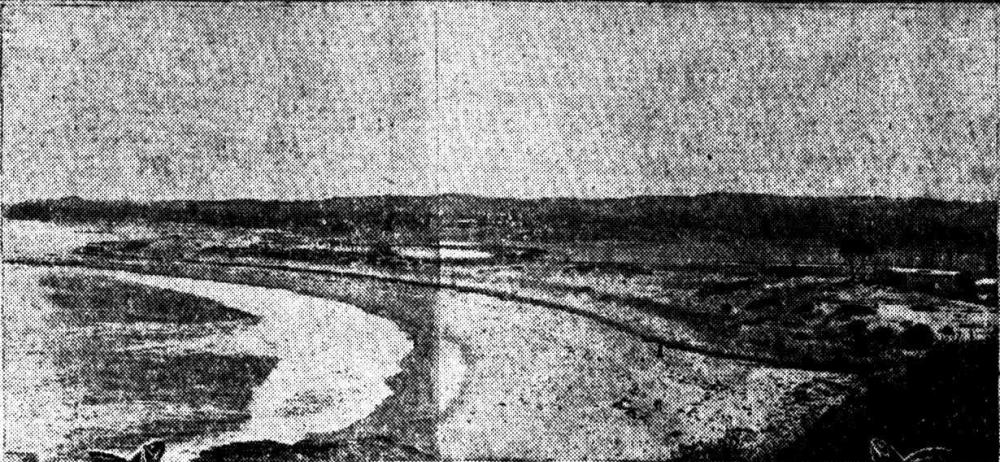
THE BEACH FRONTING BROCK'S ESTATE.
MAGNIFICENT LANDSCAPES. Some of the landscapes surrounding this Brock Estate would be worthy 'subjects for the brush of a Turner or a Corot. As one approaches it from the Newport-road, for in stance, an entrancing view is met with, the road winding prettily through undulating country, magnificently timbered and clad- with wild flowers. The property itself lies in a hollow of a cup like appearance, and on every side save the east it is protected by glorious hills. One can therefore enjoy all the benefits of the sea, air without the discomforts of the gales. The large fortune spent originally on this estate has made it a model site for fine homes. What Mr. Brock left undone Mr. Arthur Rickard has accomplished, and I see that next Anniversary Day that enterprising gentleman will offer those fine allotments to the public. Truly, they are very tempting morsels of the earth's surface, and especially so because the estate is splendidly subdivided and good wide streets, made throughout. The allotments are exceptionally large, and as the soil is excellent, the week-ender who purchases one of them may have a perfect orgie of flower and fruit-growing. If example goes for anything this estate should be the scene of some beautiful homos in the near future, for not only the mansion but several adjacent buildings have set a high architectural standard. 'Since Pott Pointing, has given way to week-ending It is quite likely that palatial residences will adorn this spot, especially as there Is no other land with ocean frontages for sale near there.
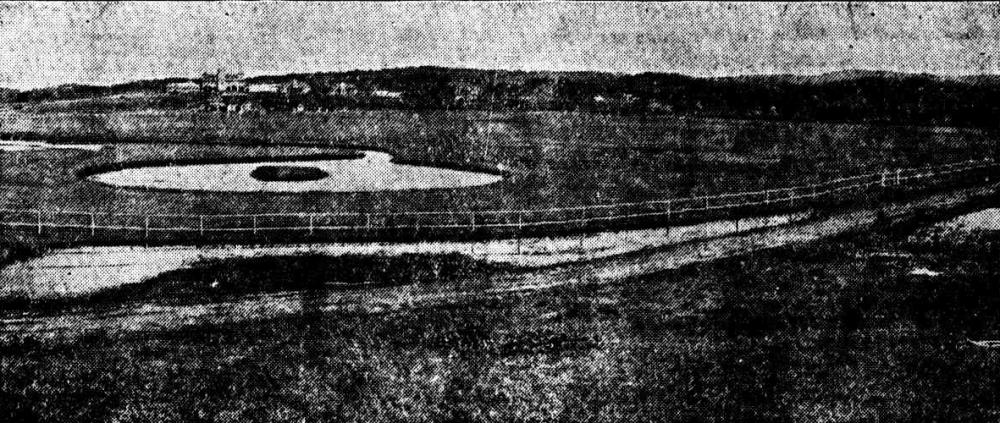
A SECTION OF BROCK'S ESTATE.
A GOOD INVESTMENT. The only need for the development of this fine area of country Is the tram, but the Newport extension may be regarded as a certainty and only a matter of time. The surveyed route, I am Informed, is along the road which fronts Brock's Estate. Although no definite promise has been given, it is generally understood that the tramline will shortly be proceeded with. When this is accomplished the estate will be within a comparatively short tram ride of Manly, and therefore within easy reach of the city. In these days of rapid transit and, a growing inclination, to plant homes in broad spaces, Mona Vale need not be considered too distant. The trip all the way from the city is such a glorious one that the travel-loving Sydney man will doubtless regard the distance as more of an advantage than otherwise. As an Investment, of course, property In this locality is a particularly good thing at present, for when the work on the tramline does start values are bound to take a leap 'upwards, and - there is no likelihood of them ever coming down again. Week-end holiday makers would do well to wait for Anniversary Day, as there might be a chance of getting in on this excellent proposition at bargain prices.
THE MANSION AS A HYDRO. On Thursday, last Brock's Mansion came Into its own when It was opened by Mrs.- Arthur Griffith, wife of the Minister for Public Works, as a hydro. At the invitation of Mr. Arthur Rickard (lessor) and Mr.' F. W. Fox (lessee) a large number of people attended, and the ceremony, which has already been reported in "The Sun", was a complete success. No better idea could have been conceived than to convert this magnificent building into a hydro. Mr. F. W. Fox, who is a well-known gentleman, and has been long and honorably identified with city business life, and his good lady, Mrs. Foy (who has large and fashionable guest establishments at Neutral Bay), are to be complimented upon their enterprise in undertaking this venture, and deserve every possible success. For several years past, and particularly since surf-bathing became popular, the need has been felt of a really first-class accommodation house near the seashore. The hotels and boarding-houses at the beaches have proved, inadequate to accommodate, in the best style the great and growing number of families who desire to spend their summer vacation at the seaside. Taking a furnished cottage is the only other, alternative, and this has decided disadvantages. In the first place, the majority of people cannot afford a sufficiently long vacation to make it worth while. Again, the responsibility of house keeping greatly detracts from the pleasure of a holiday. Is it any wonder then that the question is asked again and again: "Where is there a really first-class place to stay, at the sea side, where one may enjoy every comfort and have absolute peace and quiet— a place equal to the resorts of Europe and America?" We now have the answer: in the Mona Vale Hydro. The building alone is a source of never-ending delight. It is as the pictures denote, a palatial structure, and an architectural triumph. The decorations, both externally and Internally, are extremely artistic, and a constant pleasure to the eye. This octagonal building is constructed of brick and wood. The upper portion contains a ballroom 42 x 42, with a specially-constructed floor. The main entrance hall is lavish, and the mansion contains, all beautifully designed, a -billiard-room, ladies' lounge, promenade roof, smoke-room, ballroom, and theatre. The dining hall, which, is about 36'x 72 feet, is very large, and Imposing. The sights of the building alone should prove a continual joy to those who are fortunate enough to secure apartments there. It is quite a pleasure to roam around the mansion with its great staircases, its stained glass windows, its huge columns, Its beautiful mantels, and the general ornateness of its spacious rooms. There are 25 bedrooms and six bathrooms in the main building, though there are adjacent cottages where there is more accommodation. One of these, for example, is extremely handsome with its tiled roof and its large crescent-shaped tiled verandah with bay windows on each side. The front door of this villa gives entrance to a very large reception room, and attached to the premises there is a studio and music saloon, built of brick, with large lead-light, windows and wood-panelled ceilings. Both from, the Mansion and the adjoining buildings glorious views are to be obtained. For miles the coast, broken into enchanting bays and coves, yields a panorama of great beauty, and the charming undulating character of the back country reveals some exquisite landscapes. Here, then, is delicious peacefulness and rest with nature smiling all around one. Everything has been done by Mr. Fox to ensure the comfort of his guests. He has arranged a cuisine of the highest standard; hot and cold baths are to be obtained in plenty; every room is handsomely furnished; there is a large motor garage and accessories.
The hydro is particularly well suited to business men who desire to get away from the city for a few weeks and recuperate their physical and mental faculties, or for country people who need a change at the seaside. No better place than this could be found for the enjoyment of all healthy natural pleasures. What was intended as a racecourse and polo ground now makes ideal golf links, and devotees of this sport could not be better provided for.
As already pointed out, surf-bathing may be enjoyed with every degree of comfort and safety. There are also facilities for tennis and cricket, and plenty of good fishing may be obtained. The hydro is, therefore, not only a magnificent structure sumptuously furnished— it is the home site of all those pleasures that do most to make life worth living. A convenient motor service to and from Manly has been established, and the business man who must attend the city daily is thoroughly provided for in the time-table. For the benefit of the touring -motorist; equestrians, and others, Mr. Fox has arranged to cater for lunches, dinners, and afternoon teas, and can provide for parties or picnics of any description by previous notice.
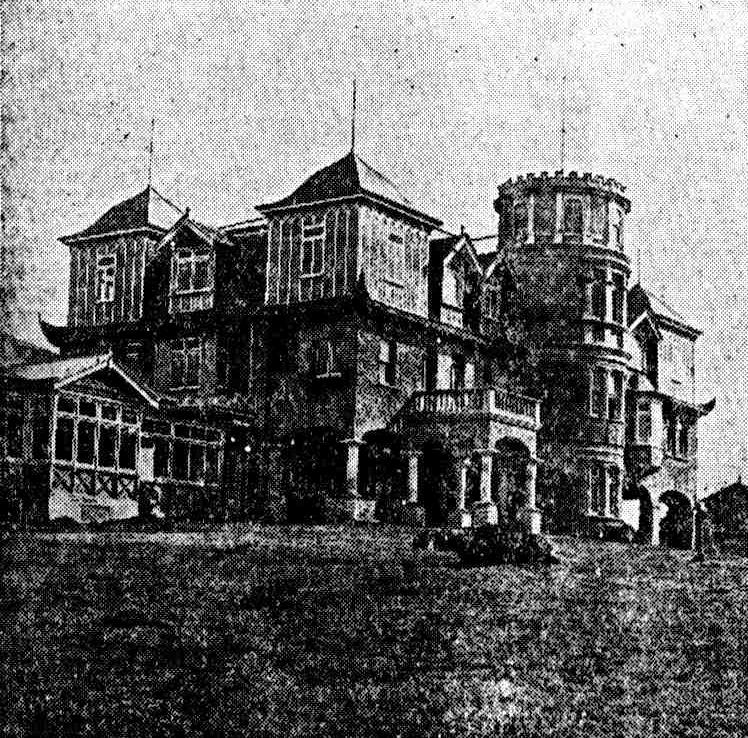
ANOTHER VIEW OF THE HYDRO.
WHERE TO SPEND THE WEEK END. (1910, December 25). The Sun : Sunday Edition (Sydney, NSW : 1910), p. 11. Retrieved from http://nla.gov.au/nla.news-article231015197
The Oddfellows' Hall, Manly.
Saturday last, March 8, was a red-letter day in the annals of Oddfellowship at Manly, it being the occasion of the opening of this new hall, built by the Native Rose Lodge. The building was only started some six months ago, and the lodge are to be congratulated on the success which has attended their efforts. On the arrival of the afternoon boat from Sydney, which brought a number of brethren from other lodges, a procession was formed, and, headed by the very nice band belonging to the Manly Fire Brigade, under the leadership of the bandmaster, Mr. Hedges, marched through the principal streets to the hall. The usual ceremony, in accordance with the rites of the Manchester Unity Order of Oddfellows, was then performed by the officers and brethren of the craft from the various lodges in Sydney. Mr. A. Hilder, Mayor of Manly, was in the chair, andspoke in glowing terms of the progress of the" Brighton of Australia."
Speeches were also made by P.G.M. Sutton, P.C.S. J. Gelding, G. M. Pitt, Esq., and the Rev. R. S. Willis. On the platform were also Messrs. T. Rowe, G. A. Murray, G. W. Barker, J. B. Smithers, J. T. Smith, E. Hayes, Rev. T. Olley. The architect of the building was Mr. Percival C. R. Rowe, and the contractors Messrs. Eaton Brothers. The trustees of the hall, Past Grands, W. Johnson, W. Murray, and J. Humphrey, deserve great credit for their energy in the matter of the building. The Native Rose Lodge was started there about four years ago, and at present theirs is the only public room available in Manly. The visitors returned to town in the evening, highly pleased with their afternoon's outing. Queen Victoria may be held personally liable for a share of the losses of the Glasgow Bank failure. A woman died recently in England who held a good deal of the stock. Having no heirs, her property went to the Crown, and now the bank's lawyers hold that the Queen is personally liable, so far as that stock is concerned. The Oddfellows' Hall, Manly. (1879, March 11). Evening News(Sydney, NSW : 1869 - 1931), p. 4. Retrieved from http://nla.gov.au/nla.news-article107152589
ODDFELLOWS' HALL for MANLY.
The signs of progress that Manly has recently shown were rendered still more apparent yesterday, when the foundation-stone of a new Oddfellows' hall was laid there by the Hon. John Sutherland, Minister of Works. The proceedings of the day were commenced by a procession, which was formed close to the beach, and marched with the banners of the order to the ceremonial scene. Besides the brethren of the Native Rose Lodge, who have undertaken the construction of the building in question, the following members of the Grand Lodge of the Manchester Unity of Oddfellows were also present, andtook part in the procession, viz. :- P.G. Kettle, P.G. Hinchey, P.G. Chapman, D.G.M. Smith, P.S. Lutton, G.S. Gelding, and P.G. Scofield. The Hon. George Thornton, Mr. George Rowe, the mayor of Manly, and Aldermen Hayes and Peters were likewise present.
A brief description of the hall will here be opportune. It is simple in arrangement, with an entrance porch leading into a spacious entrance hall. On either side are two lodge rooms, 14 feet by 10 feet 9 indies. Proceeding on is the large hall, with an arch entrance. The hall is 51 feet long, clear of the stage, by 29 feet-wide, and is lighted from the sides by semi-headed couplet windows. At the end of the hall is a spacious stage, entered from the floor of the hall by steps, and likewise at the back from a dressing-room. Underneath the stage the space is utilised as a store and lumber room. The roof of the hall is formed of four pair of principals, and lined with alternate boarding of cedar and pine.The walls inside are plastered, with the exception of a space of 4 feet all round the building, under windows, which is cemented with scratch bead dividing the plaster from the cement. The end where the stage is situated will be relieved with a slight decoration of stencil patterns. The inside altogether will rank as one of the neatest and most commodious of any of the suburban halls belonging to the body. The front is of stone chiselled, built in foot courses, with a bold entrance porch. The front is nicely broken and balanced, with long couplet semi-headed windows, with projecting bands around the same. On either angle of the front are panelled and moulded piers, surmounting which is a bold moulded cornice or entablature, with moulded panelled freize. The top or centre is marked by the central portion rising in the form of a pediment,which is also panelled and moulded. The sides are built of brick, are divided into bays by piers, with semi-headed couplet windows, and will present a uniform and pleasing aspect. When completed the building will add much to the architectural appearance of Manly Beach, and speaks well for the rapid advancement of the place. The contractors for the building are Messrs. Eaton, Brothers, of North Shore ; and the architect is Mr. Percival C. R. Rowe, the son of one of the leading architects of our city.
Everything having been got ready, and the large assemblage of ladies and gentlemen present having formed themselves into a circle around the stone,
Mr. THOMAS ROWE addressed the spectators. He said he had been requested to present the Hon. John Sutherland with the necessary tools for performing the very important work he had to do, and he entered upon it with a great deal of pleasure. The articles he had to present were the mallet and trowel, the latter of which bore a suitable inscription.He felt great pleasure in welcoming their friend to this beautiful district. He had pleasure as well because of his connection with the Municipal Council as with the Native Rose Lodge of Oddfellows. During the last twenty months miles of streets and thousands of yards of kerbing had been formed, and it would be admitted on all hands that Manly was progressing. They had a Minister present amongst them, and he doubtless would see how desirable it was that municipal bodies should be assisted. The Oddfellowswho were building this hall only numbered thirty subscribing members, and had only been four years in existence, and this was the result - this hall - of their four years' labour. He trusted, in conclusion, that the Native Rose Lodge would continue their charitable deeds, and that they would progress and flourish. (Applause.)
Mr. SUTHERLAND then, in the customary way, placed a bottle containing the colonial newspapers, several documents connected with the order, and one or two coins in the stone, and having seen that it was squared, and having tested it with the mallet presented to him, he said : " In the name of the Great Architect of the Universe, and in the presence of this company, I declare this stone to be truly and solidly laid." (Loud cheering.) From the top of the newly laid stone he then addressed those assembled. They would not he said expect him to say much; indeed he could not from the state of his health. Had he not had a strong feeling towards the order he would not have been present at all. He desired before saying anything regarding the order
to thank the mayor of Manly for the presentation that had been made to him for the purpose of laying this stone. He trusted that the hall, of which he had just laid the foundation stone, would be a memorial of great benefit to the people generally. The society in connection with which this stone had been laid had branches in almost every town in this colony. By the paper that had been put into his hands, he was informed that on the 10th September, 1864, the foundation stone of a new Oddfellows'Hall was laid at Balmain ; and that on the 14th October,1867, a foundation stone of St. John's Lodge, at New-town, was laid by himself, and was now one of the most prosperous lodges in New South Wales.He hoped that this lodge would soon be able to say not only that they had numbers, but that they had funds and respectability equal to that lodge. On the 13th of March, 1870, he laid the foundation stone of the present Oddfellows' Hall, which, when completed, was one of the best buildings in that portion of the city of Sydney ; and on the24th of May, 1877, the foundation stone of a new Oddfellows' Hall was laid at Ashfield by Mr. Pope. Since 1872 he did not see that they had done anything in the way of building halls for the benefit of the members of the society, and not for the benefit of the members of the society only, but for the benefit of the community generally. He had been informed that this society at present in New South Wales numbered no less than 8000 members, and belonging to those 8000 members there was a capital of £58,589, and last year the subscriptions amounted to £16,500. He asked those who sat around, and those who wished to pry into the affairs of this society, to consider what benefits this society were conferring on the public in one twelve months. Sup-pose they were put on a par with the other charitable institutions, what amount would they have to receive from the State ? That was a question that every one interested in the distribution of the public money would yet have to look to.The charitable institutions of this colony were coming to be very expensive, and it was only by such combinations of men as the Oddfellows for the purpose of relieving one another in sickness and distress - it was only by the united efforts of such men that the State was relieved of a large amount of pauperism that must have been thrown upon it,Not only, too, was it the prevention of pauperism,but they taught men to be independent. They believed that every man who had his health should earn his daily bread by his own toil. They wanted men to learn to depend on themselves, to know that they should not be given crutches, but should stand on their own limbs. This lodge which had only been four years in existence, and numbered only 30 members, had undertaken this hall. There was an example for his worship the Mayor, for there was not even a town hall at Manly yet. He supposed they were all working men for working men constituted the great body of Oddfellows. Here were these 30 men building a hall,and his worship the Mayor who had the central of all the property in Manly, had not made a commencement with a town hall yet. He hoped the next time he came down he would come to assist in laying the foundation-stone of a town-hall for Manly. The place was worthy of it, and the Mayor was worthy of laying it. He would now say a few words to those who were not members of this society,and to those young men who had not joined any of these societies. In societies of these kinds, where halls were built,men met together without interfering with each others prejudices.
They were a fraternity whose broad foundation was universal brotherhood, which opened the doors of relief and sympathy to all, which taught the secret and sublime sentiments of friendship and love, and clothed their adherents with the dignity of truth, and which was owned by heaven, and conferred incalculable advantages on man. Let them then be true to their professions. Let their walk and conversation in life be such that the world should be compelled to acknowledge the sublime theory they taught. Thus they would live in the enjoyment of the consciousness of having performed their duty to their Maker and fellow-men ; and when the time came for them to leave this earth and join the vast brotherhood beyond it they would be able to look back on a life well spent, and be prepared to meet him who had taught them that love for their brethren here was a duty incumbent on the children of their Heavenly Father. In this society he had always felt a deep interest, because he had seen its usefulness, and had been a member of it for over forty years. He had never received a penny of its money, and he thanked God he never needed it. It should be the duty of all true Oddfellows to consider not what they should receive, but what they can confer on others. He would ask them to follow him in these few lines :-
" Let others tread the thorny paths of fame,
And earn by strife or politics a name ; Be ours the ways of pleasantness and peace -
Be ours the task to bid distress to cease,To cheer the hours of poverty and pain,
To hear no voice ask for our aid in vain, To take the anguish from the parting groan,To hush the widow's low despairing moan,
To glad the orphan's young and guileless heart,And generous feelings cause in all to start.
Tho' odd our name - tho' wrapt in mystery's shroud,Our acts - our deeds - shall speak for us aloud;By them alone we seek to stand or fall,We hold the had of Fellowship to all, -
Could but the world our secret actions see, Mankind one mighty Brotherhood would be "
Mr. Sutherland concluded amidst loud cheering. Mr. SCOFIELD, P.G., in a short address in which he alluded to the many charitable acts done by the Manchester Unity, presented P.G. W. Johnston with a handsome watch in recognition of his services to the lodge.
Mr. JOHNSTON responded in fitting term's. An adjournment was then made to the pavilion, where refreshments were partaken of, and in the evening the festivities were continued by a concert. ODDFELLOWS' HALL for MANLY. (1878, September 27). The Sydney Morning Herald (NSW : 1842 - 1954), p. 6. Retrieved from http://nla.gov.au/nla.news-article13419467
NEW ODDFELLOWS' HALL, MANLY, NEAR SYDNEY.
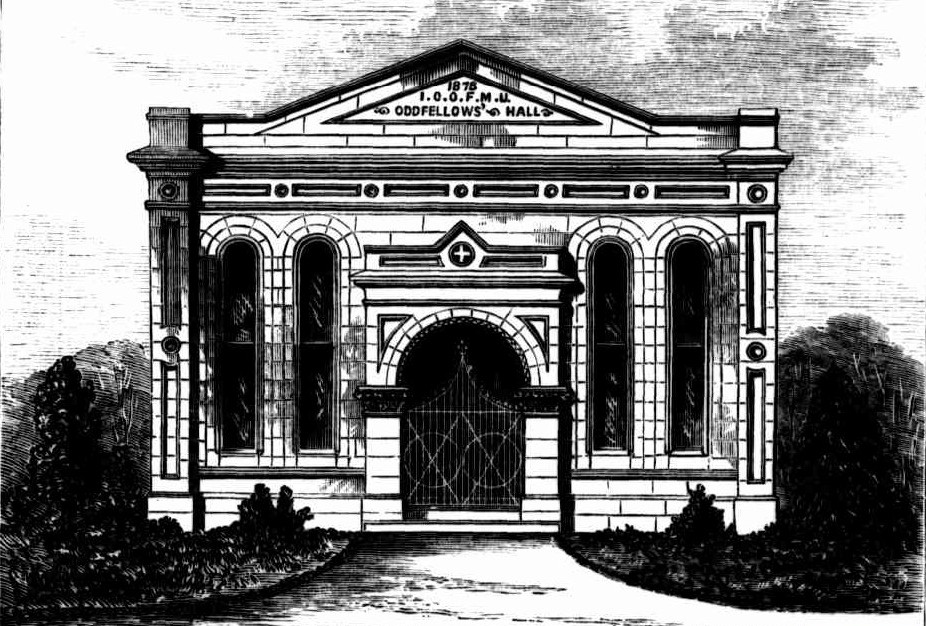
The new hall is simple but appropriate in arrangement.There is in the design of the architect, Mr. Percival C. R.Rowe, an entrance porch leading into a spacious entrance hall,flanked on either side by two lodge-rooms, 14ft by 10ft 9in in dimensions. There is then an arched entrance to the large hall, clear of the stage, 51ft long, with a width of 29ft,lighted from the sides by semi-headed couplet windows. A spacious stage will be erected at the end of the hall, access to which will be by steps from the hall floor, and also by the back from a dressing-room. The space underneath the stage will be utilised as a property-room. The roof of the hall is formed of four pair of principals, lined with alternate boarding of cedar and pine. The walls inside will be plastered, with the exception of a space of 4ft all round the building, under windows, which will be cemented with scratch bead dividing the plaster from the cement. The end where the stage is situated will be relieved with stencil patterns. The front is of stone chisselled, built in foot courses, with a bold entrance porch, and is nicely broken and balanced, with long couplet semi-headed windows, with projecting bands around the same. On either side of the front are panelled and moulded piers, surmounting which is a bold moulded cornice or entablature, with moulded panelled frieze. The top or centre is marked by the central portion rising in the form of a pediment, which is also panelled and moulded. The sides are built of brick, and are divided into bays by piers with semi-headed couplet windows, and will present a uniform and pleasing aspect, while the interior will rank as one of the neatest and most commodious of any of the numerous suburban halls around Sydney. The contractors for the building are Messrs. Eaton Brothers, of North Shore,and it is likely the edifice will be available for lodge purposes, &c., in a very short period. Illustration of Building. New Oddfellows'Hall at Manly. (1878, October 5). Australian Town and Country Journal (NSW : 1870 - 1907), p. 25. Retrieved from http://nla.gov.au/nla.news-article70595504
ODDFELLOWS' WAR MEMORIAL
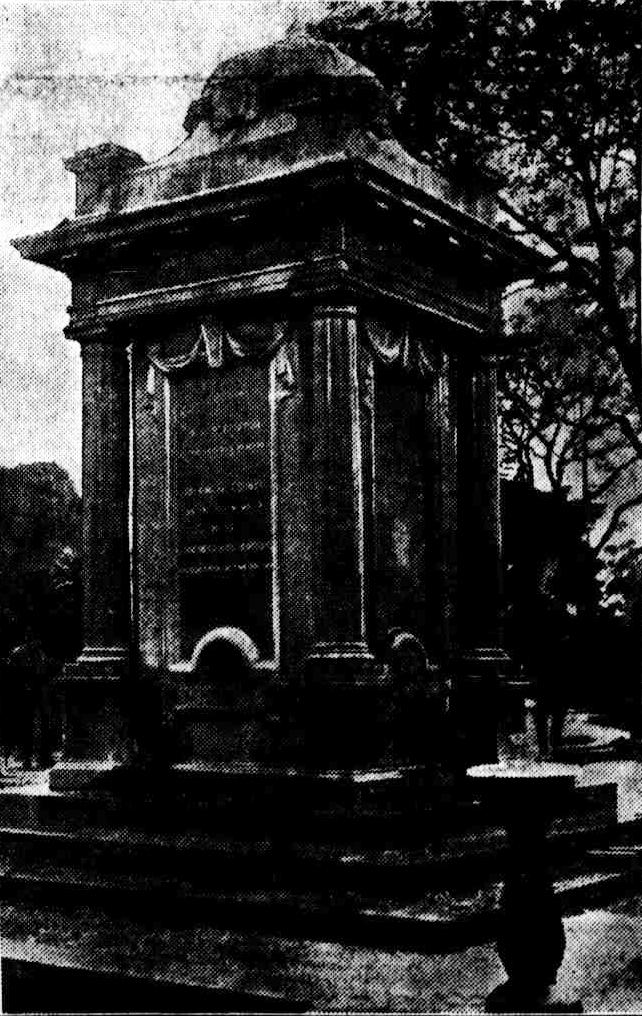
Memorial drinking fountain in Hyde Park, at the corner of Park-street and Elizabeth-street, which has been erected by the Grand United Order ofOddfellows to the honor of members who fell in the war. ODDFELLOWS' WAR MEMORIAL (1921, May 11). The Sun (Sydney, NSW : 1910 - 1954), p. 1 (FINAL EXTRA). Retrieved from http://nla.gov.au/nla.news-article221475120
A Few Earlier And Other Memorial Fountains:
Unveiling a Memorial Fountain.
The official unveiling of the memorial fountain, erected by the residents of Willoughby to the memory of those volunteers from the district who lost their lives while on active service in South Africa, was performed on Sunday afternoon by the State Minister for Defence (Mr. John See) in the Chatswood Park.
The ceremony was accompanied by much military display and popular enthusiasm. The attendance at the church parade in Chatswood Park, apart from the military, was a large one, and the scene presented was brilliant and animated. Special military trains were despatched from Milson's Point, and the troops upon arrival formed up outside the Chatswood Station by regiment* under the command of the senior officers present. The troops taking part in the parade were : — A detachment, 50 strong, representing the Imperial Draft Contingent, under the command of Captain Neseigb, who had with him Acting Lieutenants D'Arcy, Cameron, and Breckenridge ; Scottish Rifles, 100 strong, under the command of Lieutenant Ross and Lieutenant M’Kenzie ; the 6th Regiment, 250 strong, under the command of Captain Cook, who had with him Lieutenants Hughes, M'Kye, Jenkius, Dowell, and Scott ; the National Guard, under the command of Lieutenant M'Donild; the 7th Regiment (St. George's Rifles). 300 strong, under the command of Captain Crane, who had with him Lieutenants Davis Walsh, Watt, Shears, Kirkland, and Walker ; Civil Service Corps of Infantry, 62 strong, under Lieutenants Hannah, Norrie, and Rawney; a detachment of Mounted Rifles (Canterbury Half -squadron), under Captain Campbell, assisted by Lieutenants M'Kellar and Henderson ; a detachment of the Australian Horse under Lieutenant Vaughan ; a detachment of Lancers under the command of Lieutenant Timothy ; a small detachment of the 8th Regiment under Sergeant Egan: the Mounted Cadets, &c. The bands of the R. A.A. and the 6th Regiment were also in attendance. The whole of the troops, headed by the bands, marched to the park by way of Archer and Orchard streets, and upon arrival formed up in front of the dais erected close to the memorial fountain, which was enveloped in the Union Jack and Australian Ensign. Amongst the members of the general staff present on the platform were Major- General French, G.O.C., Colonel Markenzie, Captain Dangar, A.A.G., Captain King (Engineers), and Captain Lamb (R.A.A.). There were also on the platform Mr. John See (State Minister for Defence), Messrs. Duguld Thomson, G. Howarth, E. M. Clark, and A. D. Nelson, Ms.L.A., Aldermau F. S. Willis (Mayor of Willoughby), the members of the committee, Alderman C. Leplastrier (hon, treasurer), Messrs. T. Hawkins and R. T. Forsyth (joint secretaries), Major Gilchrist, and others. The church parade was under the direction of Major Cropley (7th Regiment), and the service was conducted by the Rev. Wallace Mort (senior chaplain to the New South Wales military Forces). Proceedings were opened by the Mayor of Willoughby, who presided, and briefly referred to the history of the memorial, which had been erected at a cost of upwards of £80. Towards that cum a substantial amount had already been subscribed, which he hoped would be liberally augmented, if not entirely contributed, by the collection to be made that day, to gather with sufficient to defray the costs of any further inscriptions. The memorial fountain, standing in a conspicuous portion of the park, is of white marble and of attractive design- One the one side is the inscription, -' This fountain was erected by the people of Willoughby in memory of those local volunteers who lost their lives in the service of the Empire during the South African War, 1899-1901.
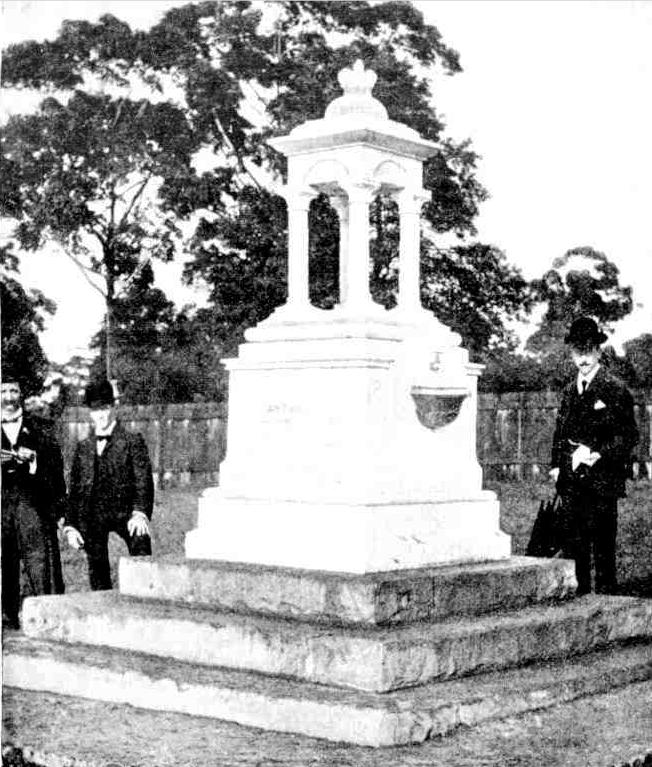
MEMORIAL FOUNTAIN IN THE CHATSWOOD PARK. Erected by the people of Willoughby in memory of those local volunteers who lost their lives in the service of the Empire during the South African War, 1899-1901.
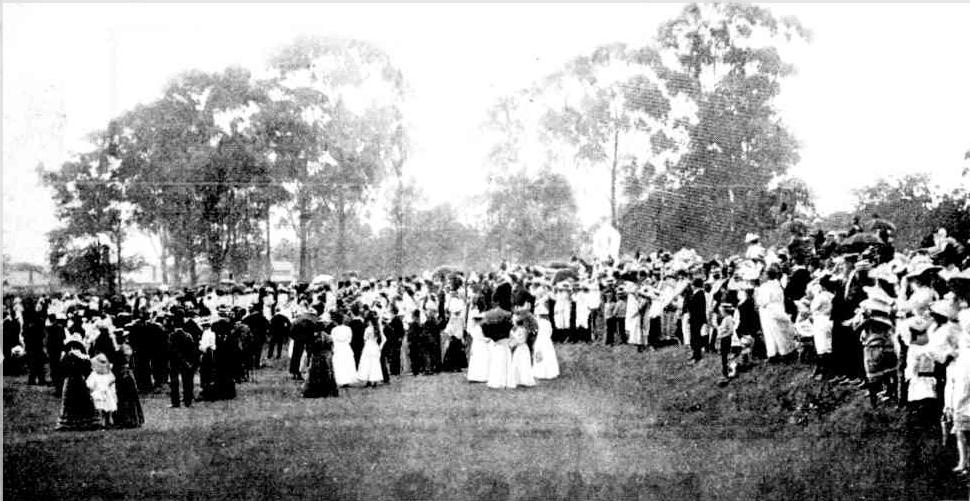
UNVEILING THE MEMORIAL FOUNTAIN, CHATSWOOD PARK, MARCH 10. VARNEY PARKES. Unveiling a Memorial Fountain. (1901, March 16).The Sydney Mail and New South Wales Advertiser (NSW : 1871 - 1912), p. 668. Retrieved from http://nla.gov.au/nla.news-article165292684
Tamworth Memorial Fountain
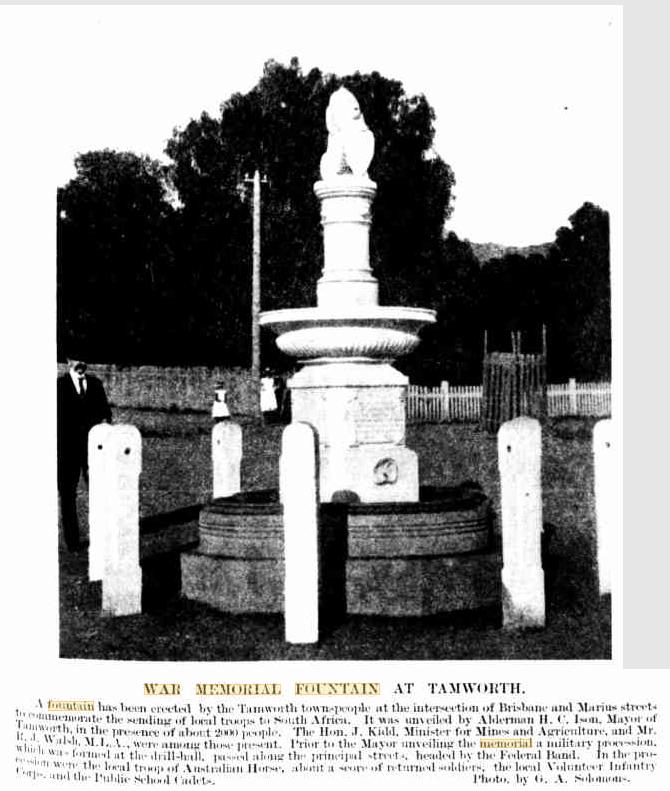
A New Luminous Fountain. (1901, October 26). The Sydney Mail and New South Wales Advertiser (NSW : 1871 - 1912), p. 1049. Retrieved fromhttp://nla.gov.au/nla.news-article165232470
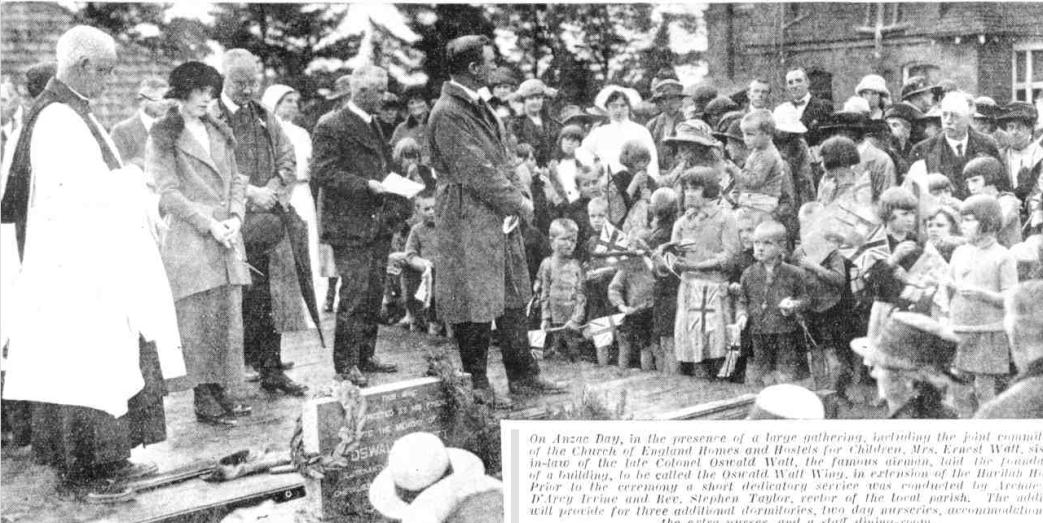
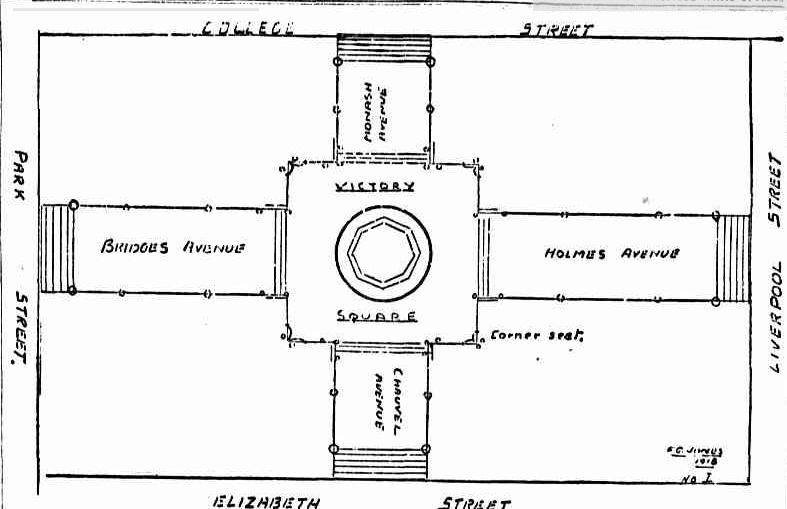
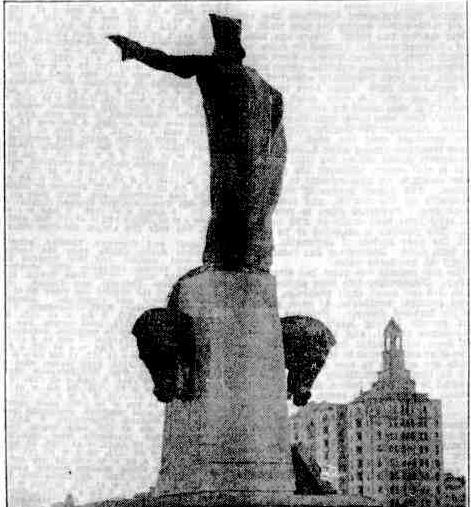
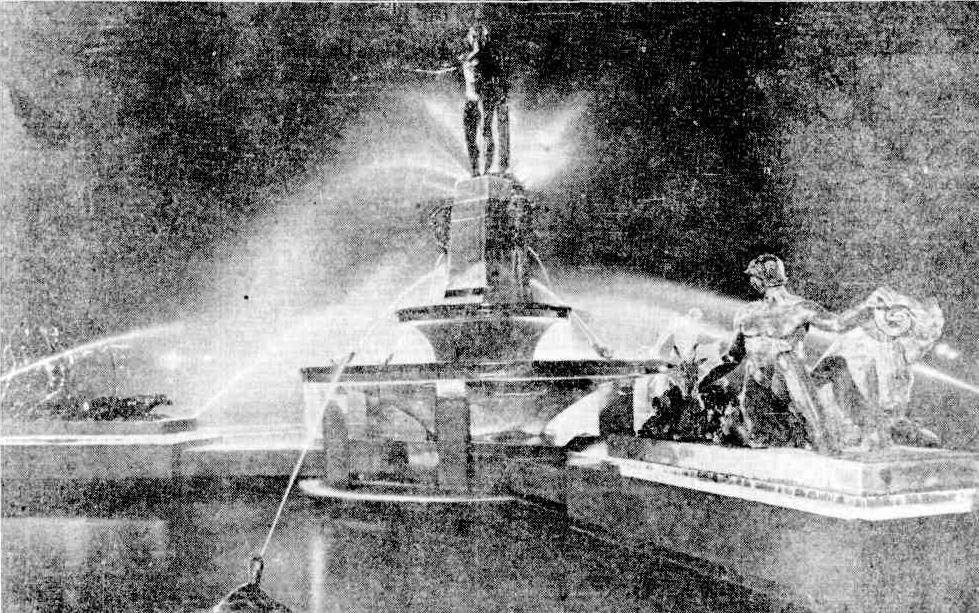
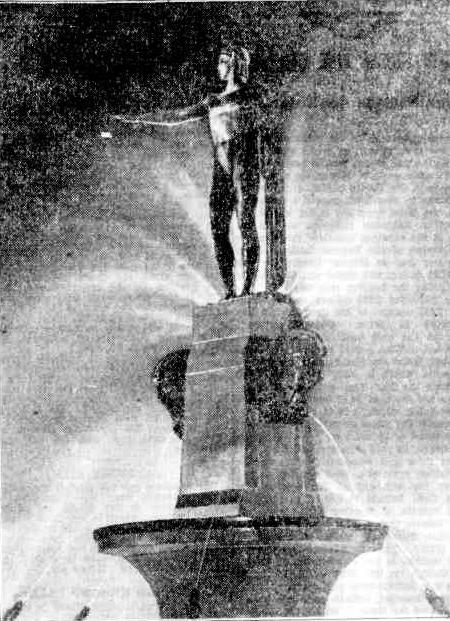
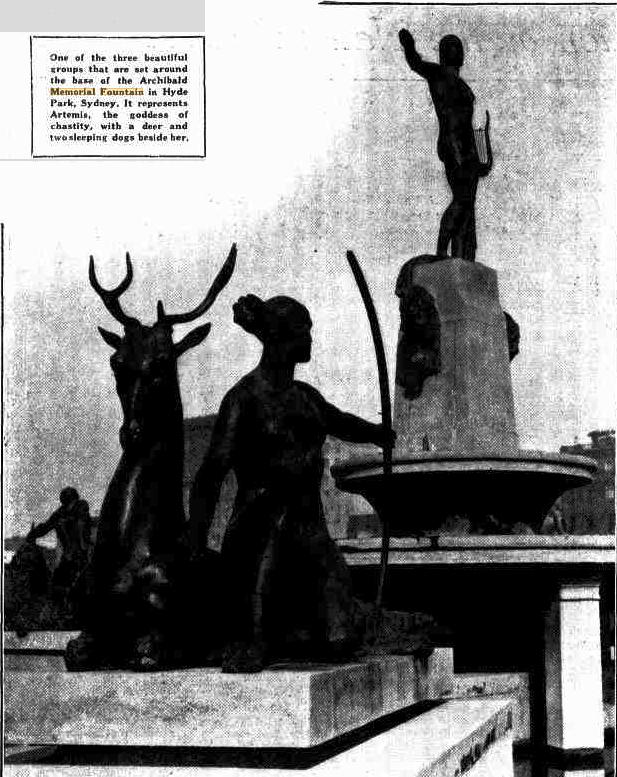
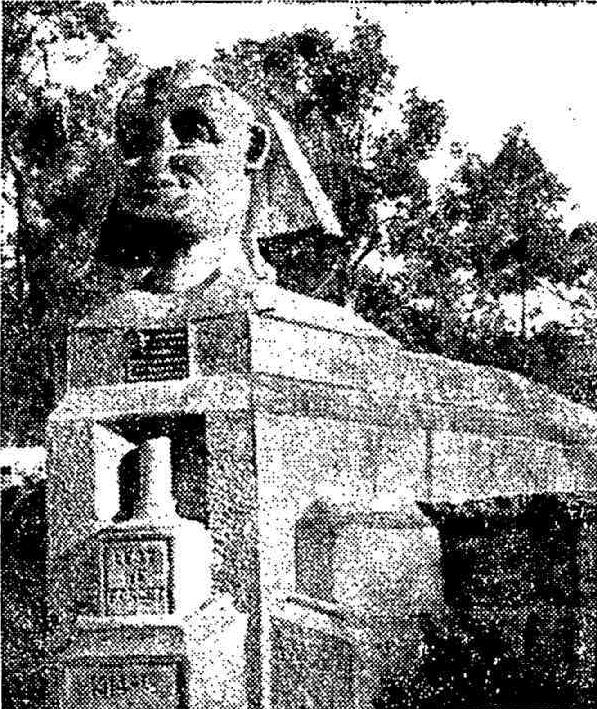
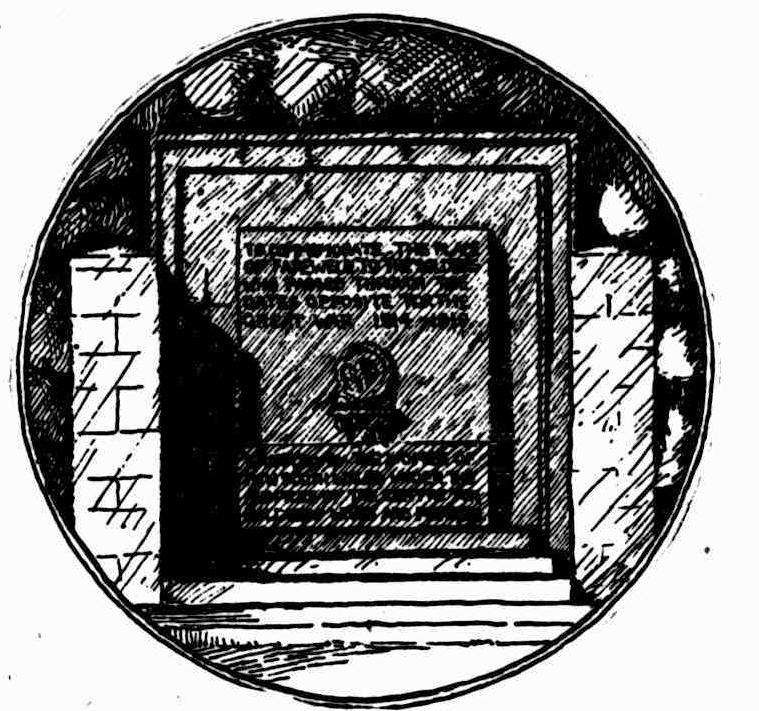
NATIONAL RESERVE.

